1970 Bad weather at the beginning of the year made inroads into the availability of the St Pancras - Bedford diesel multiple unit fleet. Many ran with short formations, whilst a number of Type 2s were used, both to haul the units themselves or scratch sets of mainline coaching stock. More serious problems affected services south of the Thames when snow and freezing rain arrived on January 6th. Severe icing affected the Portsmouth direct line between Pirbright and Winchester, whilst on the Brighton line between Balcombe and Haywards Heath freezing rain falling at 6.00am coated the rails with ice an inch thick. For most of the morning the services were in chaos over this line, the use of diesels being the only certain method of assisting the electric units and with the reduction in freight services, the diesels were few. The closure of the Lewes - Uckfield line had also deprived the operating authorities of an alternate route. Interestingly a similar problem had struck this very location on New Year's Eve causing the same operating difficulties. Over on the South Eastern Division things were only a little easier. The de-icing trains were operating but were generally ineffective due to the rapid temperature fluctuations. No trains ran between Tonbridge & Orpington or through Maidstone East during the morning creating numerous difficulties. On 8th blizzard conditions were encountered during the evening rush hour. The next morning the derailment of unit 5033 at Plumstead closed the North Kent line most of the day. The snows of the 6th also impacted services in Scotland.
On the morning of January 8th damage was caused to the track at Dawlish due to a south-easterly gale coupled with high spring tides. Ballast on the down line was washed out, leading to single line working. Some damage was caused to the down platform at Dawlish.
Very strong winds during the evening of February 2nd toppled a tree between Woking & Guildford, the line remained blocked for three hours with services diverted via Aldershot.
A major blizzard occurred on February 12th over southern England, in the London area snow was still on the ground on February 15th. Snow was responsible for blocked points at multiple locations between Cannon Street and Ramsgate on February 17th.
March 4th brought a major snowfall to the southern half of the country causing major disruption of the electric services between Euston and Birmingham. It is reported that the heavy snowfall affected the standing electric locomotives, the weight of the snow causing the pantographs to lose contact with the overhead, and affecting the proper working of the raising mechanism. Once the seriousness of the delays was recognised services were diverted to St Pancras and Paddington, which despite their heavy snowfall (16in reported in many places) seemed to handle the traffic very well. The Walsall area suffered very badly with the morning service devastated, dmu's filling in for the failed local electrics. The Bescot and Saltley snow ploughs were put to work powered by 1822 & 1725 respectively whilst steam lance equipped 1841 spent all day freeing pointwork. The SR also was hit hard, especially in the morning. Blizzard conditions in East Kent made the evening commute a little out of the ordinary. Perhaps the most serious delay was at Walmer when a Dover bound service become stuck for almost three hours.
On the lines out of Liverpool Street heavy disruption took place. The longer distance trains to Southend seemingly ran well, but most others were chaotic or were substituted by an emergency timetable. All was not helped by derailments at Cheshunt and later Angel Road, the latter blocking both lines, depriving Hertford East of its direct service to London. From Kings Cross the Scottish services were running upto two hours late.
The Pennines were hit particularly hard by heavy snows on April 12th.
The south of England suffered from severe thunderstorms during the early morning of July 8th. Electrical problems caused operating issues between Lymington & Christchurch and between Eastleigh & Basingstoke. On the Eastern Region electrical problems affected the line between Barking & Upminster.
Heavy rains struck the West Midlands on the night of August 19th/20th, flooding the north end of Walsall station. The electric Walsall - Birmingham service was maintained, but services through the station were not be resumed until the morning of August 21st.
A white Christmas was had by much of the south east. Snow had begun to fall on Christmas Eve, with no services on Christmas Day to keep the lines clear, the reduced services on Boxing Day on the Southern Region encountered multiple problems, these continued into the following days. At one point the Ashford - Maidstone line was blocked, whilst electric services were strengthened to provide more points of contact with the third rail.
![]()
1971 During the early hours of August 5th heavy rain and thunderstorms occurred in the London area, causing many operating problems. Fulwell tunnel on the Shepperton branch became flooded with the branch closed until mid-afternoon.
Moderate snowfall occurred in the Lake District/Pennines on Dec 27/28th.
![]()
1972 Blizzards struck the Grampians on January 17/18th blocking the Highland main line, delays to an overnight Inverness - Glasgow/Edinburgh service caused a five hour late arrival. Continued snowfalls over the following days caused minor delays, the parallel A9 road remained blocked for four days, partly due to abandoned vehicles.
On January 18th there was a modest early morning snowfall in the Yorkshire area, leading to cancellations in the Leeds area.

![]()
1973 On January 1st the Thames Valley experienced thick fog both in the morning and evening, causing delays during the rush hour, not helped by high rates of absenteeism.
There was snow and frost mid February, the Pennines having snow on 10th and more widespread on 15th, whilst on 14th snow in the Kent area caused operating issues.
Severe storms on May 3rd affected services on the Southend branch and closed the LTS line between Leigh-on-Sea & Shoeburyness. On May 21st resulted in flooding between Shenfield & Brentwood.
July 16th saw the rivers Sheaf & Porter reach flood stage in the environs of Sheffield station, resulting in its closure for most of the day. Most NE/SW services avoided Sheffield with a connecting service from Rotherham to Sheffield Victoria. Just over a week later in the early hours of July 22nd, flooding was reported in Bradway tunnel, with some trains being diverted via the 'Old Road'.
Heavy rains on August 7th flooded the Shrewsbury - Aberystwyth line at Caersws, a bus shuttle was established between Newton & Machynlleth.
Heavy snow was recorded in the north east on December 7th.
![]()
1974 The first two weeks of January were particularly stormy, though most of the precipitation appears to have been rain.
An exceptional high tide at Fort William on January 11th flooded the station and surrounding area including the nearby bus depot. Several coaches and a locomotive were temporarily marooned, normal services were resumed the next day.
February 6th saw a snowfall in the London area which led to issues with the points at Orpington. All trains were required to use the slow lines with stock disruption affecting the next day's services. Worse followed in the afternoon following the sending home of a Hither Green driver who refused to take a freight into the strike bound Eastern Region. This resulted in drivers walking out from seven depots, from Victoria to Faversham, few suburban line trains ran that evening in the affected area.
During early February ferocious storms brought heavy rain and high winds to the South West & southern England, with coastal areas experiencing high tides made worse by the gale force winds. On the evening of February 11th along the seawall at Dawlish the high tides flooded much of the railway with Dawlish station suffering considerable damage, much of the down platform broke up and was tossed on the tracks. Similarly at Penzance (Monday 12th) parts of the station were under water, with the exceptional high tide having dumped much debris across the tracks. Trains services were halted at St Erth until Penzance station was made usable. On the Southern Region services on February 11th between Ryde Pier Head and St Johns Road were suspended due to high seas. Elsewhere on the mainland some services were affected by tree falls, whilst a landslip near Godalming caused single line working between Milford & Farncombe. Blackheath tunnel was temporarily closed due to flooding, whilst Charing Cross & Cannon Street stations were closed for several hours.
On September 7th gale force winds and heavy rains in many parts of the country caused operating headaches for the railways. During the morning south of Rugby three WCML electric services either brought down the wires, lost their pantograph or became dewired. Another electric service ran into a fallen tree at Ashton. A speed limit of 70mph was imposed to avoid further dewirements. On the Western Region mainline services were mostly impacted by fallen trees, with some services rerouted and delays up to two hours. On the Eastern Region high winds damaged the overhead line equipment between Rayleigh & Wickford in the early afternoon, full services were not restored until the next day.
An early snowfall occurred in the south east on October 7th, with more following on the 30th.
Heavy rains during November caused a landslip at Laverton on the Honeybourne line, the up line was closed for five days from November 21st, the down line remained open but with a severe speed restriction. The Southern Region also suffered from some flooding particularly in southern Hampshire. Further east in Sussex there were major problems in the Lewes area with lines closed to electric services from November 22nd for at least three days. Local electric services were replaced by three and six car diesel electric multiple units including 1001, 1106, 1115, 1116, 1118 & 1318. By November 25th full electric service was resumed. On the lines out of Liverpool Street delays were caused by flooding on November 21st between Gidea Park, Chelmsford & Rochford.
The night of December 3rd produced heavy rain and high winds leading to a tarpaulin cover on the 22.23 Gushetfaulds - Dudley freightliner working loose and damaging the overhead equipment between Carstairs & Lamington. The damaged overhead line equipment affected the following train, a Gushetfaulds - Garston freightliner causing one of its locomotives to lose a pantograph. The train behind this, a Glasgow - Euston passenger became trapped and would reach Carlisle over four hours late. Other trains were diverted away from the WCML, with the consequent serious late running. By the next morning Class 47s were on duty at Carstairs to assist electric services through the section.
![]()
1975 Flooding between Gillingham & Yeovil Junction considerably affected Waterloo - Exeter services on January 18th. At least one service was diverted via Westbury and several Class 47s substituted for Class 33s, deeper floodwater later necessitated the use of some Class 52s. A very unusual substitution was the use of the locomotive and stock off the 17.55 Barnstaple - Exeter to work the 19.55 Exeter - Basingstoke with 25224. This service was terminated at Yeovil Junction, the passengers being transferred to the terminated 15.00 Waterloo - Exeter, which was now to head back towards Basingstoke.
On March 18th the SR experienced a late winter snowfall with icing which created operating difficulties on the LSWR lines west of Farnborough.
The Potteries on March 27th/28th were noted under several inches of snow.
A heavy snowfall on Maunday Thursday (late March) combined with a maintenance work-to-rule did not help matters, with Birmingham receiving six inches of the white stuff. Continued and prolonged snow during the first two weeks of April did not help matters, the maintenance strike eventually coming to an end on April 14th. Much of Scotland north of Edinburgh & Glasgow received heavy snowfall on April 8th with the eastern side suffering the most disruption. Snowploughs were used to clear blockages at Brora, Druimuachdar summit and between Huntly & Keith. Some locations received as much as 20 inches of snow.
An unusually late and brief snowfall over the Midlands & Pennines on June 2nd stopped a cricket match at Buxton. Snow was also reported in London and over East Anglia.
In parts of Scotland the early summer drought ended dramatically on July 14th when thunderstorms caused disruption on the West Highland line, with multiple rain induced landslides between Garelochhead and Crianlarich. Several trains were impacted by the blocked line, for the passengers the roads provided little relief as many were also in a flooded state. Some train services were diverted to Stirling with buses taking the passengers on to Oban or Fort William.
Heavy rain fell in the London area on the evening of August 14th. The Kilburn area received over six inches in one hour, flooding the WCML at Brondesbury and the DC line at Primrose Hill. Considerable disruption followed. Services were also impacted out of Kings Cross with heavy delays to late evening long distance services.
Moderate snow fell over the Highlands in early December.
On December 15th thick fog blanketed much of London and Kent, in some places temperatures were below freezing. Additional delays were incurred when engineering work at London Bridge overran its time slot, whilst at about 8.45am power failures at Shortlands and Herne Hill caused a variety of problems. Fog also affected services out of Liverpool Street on December 15th & 16th.
![]()
1976 On the evening of January 2nd severe gales brought down the overhead wires near Berkswell, stopping all traffic. A shuttle bus connected Coventry with Leamington Spa, allowing utilization of the Birmingham - Paddington services. The next morning (3rd) electric multiple units reached Coventry from Rugby, diesel multiple units provided onward service to Birmingham. At some point during the night a tree was blown down on the Coventry - Leamington route, this was cleared by mid-morning. 25236 brought the wiring train to Berkswell, by late afternoon a partial service had been resumed, with full service available by January 4th. The WCML services into Birmingham New Street were heavily delayed, as were some NE/SW services. At least two parcels trolleys were blown off the platform on to the tracks at New Street.
Further north the wires were brought down at Hest Bank, whilst debris blew on to the tracks at Winsford. Some services were terminated short of their destinations, with many passengers held overnight in local hotels at Carnforth & Lancaster. Diesel haulage was the norm until the afternoon of January 3rd. The wires were also brought down north of Shap. A number of services were diverted via the ECML, predominantly hauled by Class 47s. Later on the 3rd some WCML services were routed via the Settle & Carlisle and Leeds. The storm delayed Sealink's Larne - Stranraer ferry on January 2nd, leading to the cancellation of the 22.30 Stranraer Harbour - Euston, the stock being used the next morning for an extra service to Glasgow Central.
In the Worcester area the storm damage claimed the lives of a driver and guard when Class 52 No.1055 running light and returning from Bescot to the Western Region ran into a Curzon Street - Worcester parcels near Worcester Tunnel Junction. Storm damage had severed communications between Droitwich Spa & Worecester Tunnel Junction signal boxes.
The January 2nd gale caused flooding on the Conway Valley line between Bettws-y-Coed and Llanwrst, with multiple washouts. One diesel multiple unit was stranded, whilst the last train of the day from Blaneau Festiniog was hit by a tree, fortunately no injuries were sustained. On the Cambrian Coast line the line at Gogart halt was washed away, flooding closed the line between Dovey Junction & Aberdovey whilst the sea damaged the track between Tonfanau & Tywyn. It would be at least ten days before some sort of service was resumed. South of Dovey Junction the line was breached between there at Borth, with two three-car diesel multiple units trapped. They would work a shuttle service between Aberystwyth & Borth, with a bus service to Machynlleth.
In the Southend area a light aircraft at Southend airport was blown on to railway property, causing minor damage to the overhead line equipment on the Southend - Shenfield line.
On the East coast a very high tide in the area of Cleethorpes station breached the line to Grimsby. By early evening the integrity of the track formation was completely lost, allowing flood waters to engulf several hundred houses normally protected by the railway line. It was necessary to bring in trainloads of slag ballast to rebuild the formation. The line was repaired by January 10th.
Further windy weather returned on January 20th, speed restrictions were imposed on the WCML, with some considerable delays, but not as significant as those on January 2nd & 3rd. The wires were blown down at Shap Wells. One southbound Freightliner is reported to have both its locomotives loose their pantographs.
The Highlands received a moderate amount of snow from January 31st to February 4th.
Freezing rain impacted services between Bournemouth, Southampton & Eastleigh during the early hours of February 2nd, with ice on the conductor rails causing lengthy delays.
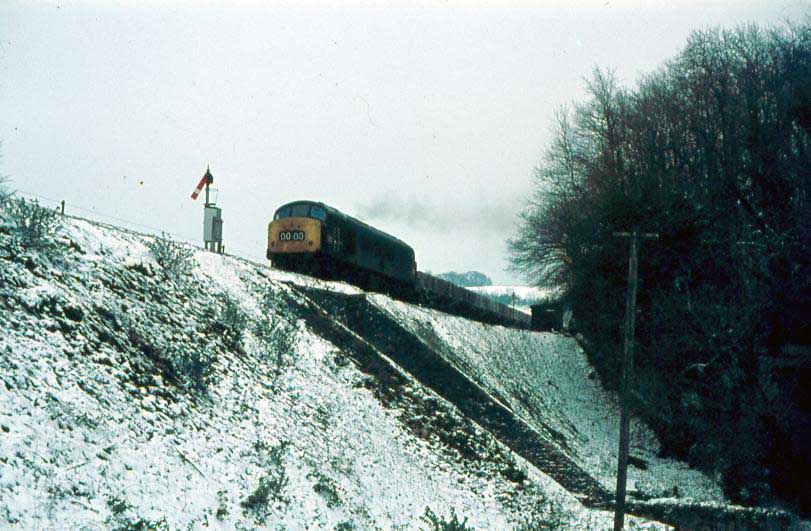
From late June into July the country was plagued with a heatwave, leading to a proliferation of lineside fires. On June 23rd an embankment fire at Tring saw at least eight services diverted from Euston to Paddington.
The Great Eastern lines also suffered multiple issues with wildfires and other connected failures. Minor delays were caused in many places due to firemen hosing down lineside fires, requiring the overhead electric supply to be turned of briefly. In the late afternoon of July 20th very heavy rain in the Ipswich area washed tons of earth across the line between Bentley & Manningtree. It was not until the early hours of the following morning that both lines became available.
On the Southern Region the heatwave produced a series of incidents commencing on June 30th with services from Waterloo affected, with the line closed between Pirbright Junction and Ash Vale. On July 4th the Woking - Guildford was closed twice during the day, whilst a severe thunderstorm caused flood damage to the previously mentioned Pirbright Junction - Ash Vale line. A fire with a serious impact occurred on July 7th at a bridge which carries the Latchmere Junction - Longhedge Junction route over the mainlines emanating from Waterloo. The mainlines were closed in the evening from about 7pm for two hours. Another serious fire occurred on July 13th on an embankment between Earlsfield & Wimbledon, closing the lines during the afternoon for about an hour.
In the midst of all this heat a thunderstorm in the Gillingham area during the afternoon of July 20th caused damage to a level crossing due to flooding, delaying several services.
On the Scottish Region a forest fire on Daviot Moor on July 9th caused delay to a number of services on the Perth - Inverness mainline. On July 21st the decking on Glenury viaduct caught fire, with services impacted whilst the Fire Brigade dealt with the problem.
Heavy rain in the late afternoon of September 28th caused numerous problems throughout the Glasgow area, over three inches of rain falling during a four hour period. The Clyde and the Kelvin overflowed their banks. Local electric services out of Glasgow Central were suspended. The collapse of the cutting walls near Port Dundas Junction closed the mainline into Glasgow Queen Street High Level, whilst the new concrete trackbed in Cowlairs Tunnel funnelled excess amounts of water into Glasgow Queen Street station, to a depth of four feet, with some water leaking into the Low Level station. Amongst the rolling stock trapped in the station was a push-pull set with its Class 27s, three other Class 27s and other assorted rolling stock. The push-pull Edinburgh - Glasgow service was diverted into Glasgow Central, whilst services from Queen Street to the north started from Springburn. Queen Street was opened on the Thursday September 30th to limited services, with normal services almost in effect by Friday.
Heavy rains on November 29th flooded the line between Lymington Junction & New Milton during the early afternoon, three trains were trapped when the traction current was turned off for six hours. The use of diesels on the Waterloo - Bournemouth semi-fasts between Brockenhurst & Bournemouth allowed the maintaining of some services. Flooding at Botley on both 29th & 30th impacted the Fareham - Eastleigh line.
The beginning of December produced a period of cold weather, particularly north of the border. On December 2nd & 3rd many WCML electric locomotives were temporarily out of service with pantograph failures due to frozen water in the air compressors. A blizzard during the night of December 3rd may have been partly responsible for the derailment of a freight at Cadder whilst setting back into a loop and then running through a set of catch points. The derailed wagons were hit by a Sighthill - Millerhill car train, with 37150 and one Cartic-4 completely derailed. Some pointwork and much track was damaged, several passenger services were terminated at Lenzie, others diverted via Cumbernauld. Recovery efforts were impeded by a continued snowfall, with operational delays reaching far into the 4th. An overnight (December 3rd/4th) Euston - Glasgow Central sleeper service suffered from freezing equipment on the locomotive, the train coming to a stand south of Carluke station. A relief locomotive was able to reach the train, but was heavily delayed in proceeding forward due to frozen brakes throughtout the train. Arrival at Glasgow Central was almost ten hours late. This night also saw a number of other electric services seriously delayed north of Carlisle due to the freezing conditions, with rescue ultimately in the hands of whatever diesel locomotives were available.
The last week of December saw light snowfall, at least recorded in the Midlands on 28th/29th.
![]()
1977
In Yorkshire heavy snow on January 13th blocked points in the Huddersfield area causing some operating challenges, whilst the Healey Mills snowplough visited the Penistone branch.
January 13th produced heavy snowfall in the Midlands, with freezing condition affecting pointwork, including those at Soho depot which delayed stock movements. Most longer distance services through Birmingham were running late. South & west of London snow fell for much of the morning and early afternoon, with freezing temperatures affecting South Western Division services. Some delays ensued but late in the afternoon the snow turned to rain, but gale force winds developed with occasional lightning, all of which caused some operational problems. On the Central and South Eastern Division the freezing snowy weather started on January 12th with serious delays occurring for the 12th's evening rush hour. Mercifully a thaw on 13th saw snow replaced by rain allowing for a return to normal services.
Snow on the Edinburgh - Carstairs route required the use of a snowplough to clear the line at Cobbinshaw summit.
Severe gales in the south returned on the afternoon of January 25th, with falling trees and other wind blown debris affecting some services.
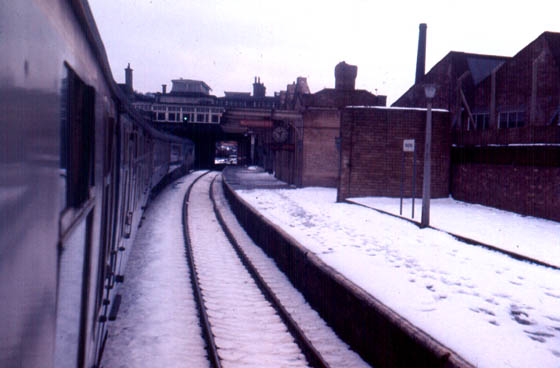
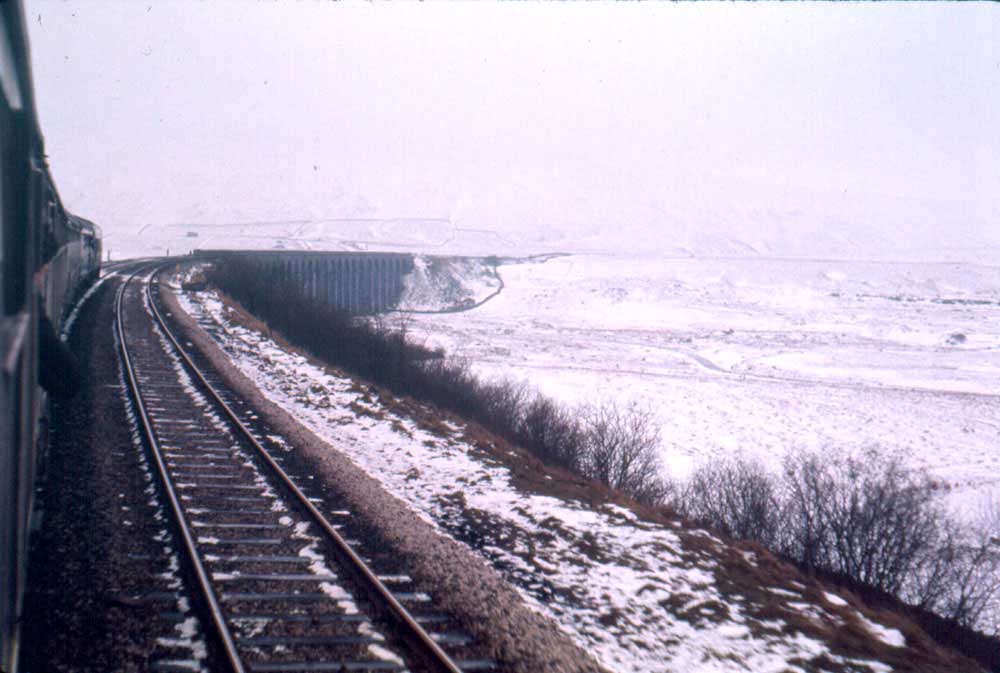
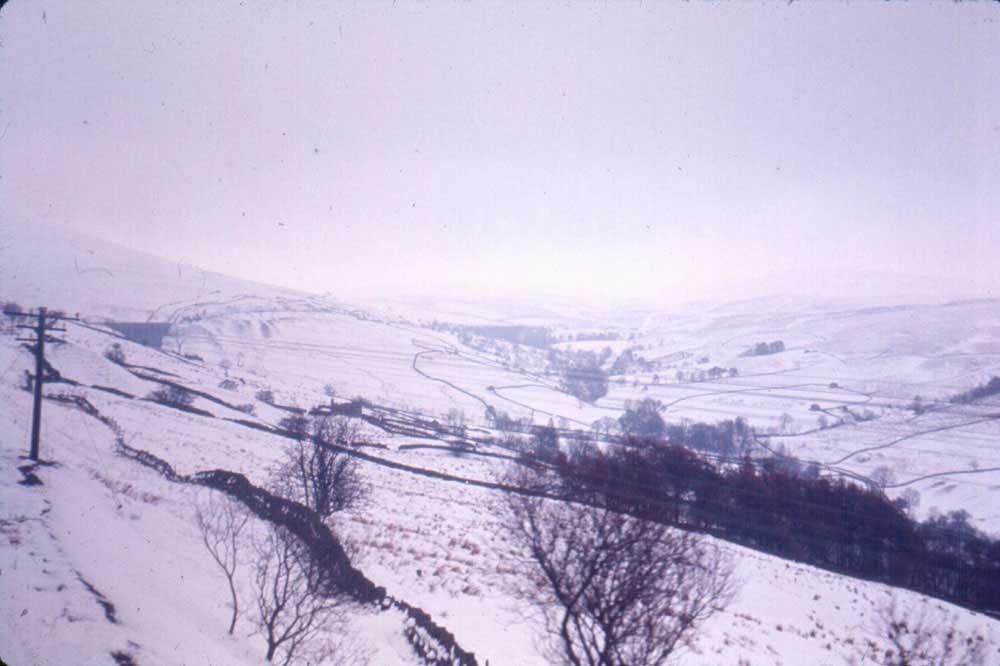
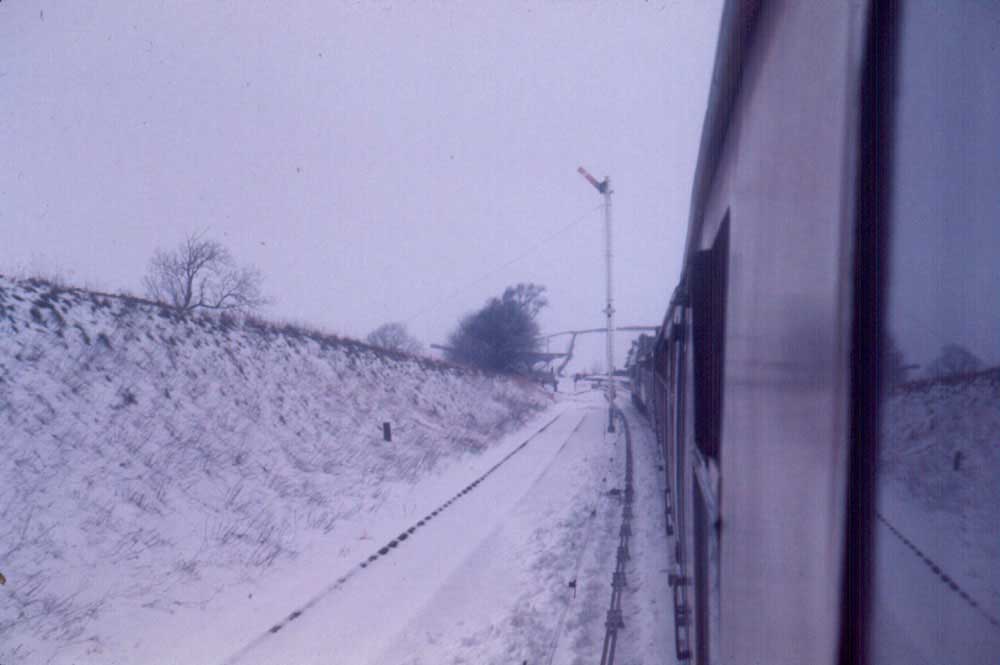
On January 15th 1977 a journey was made over the Settle & Carlisle using one of the very cheap 'Round Robin' fares from Derby. The above view is taken as we passed through Keighley with 45001, the small amount of snow here would soon turn into a much whiter landscape. The three views below show the journey progressing and includes views of Ribblehead, looking back down Dentdale and approaching Kirkby Stephen.

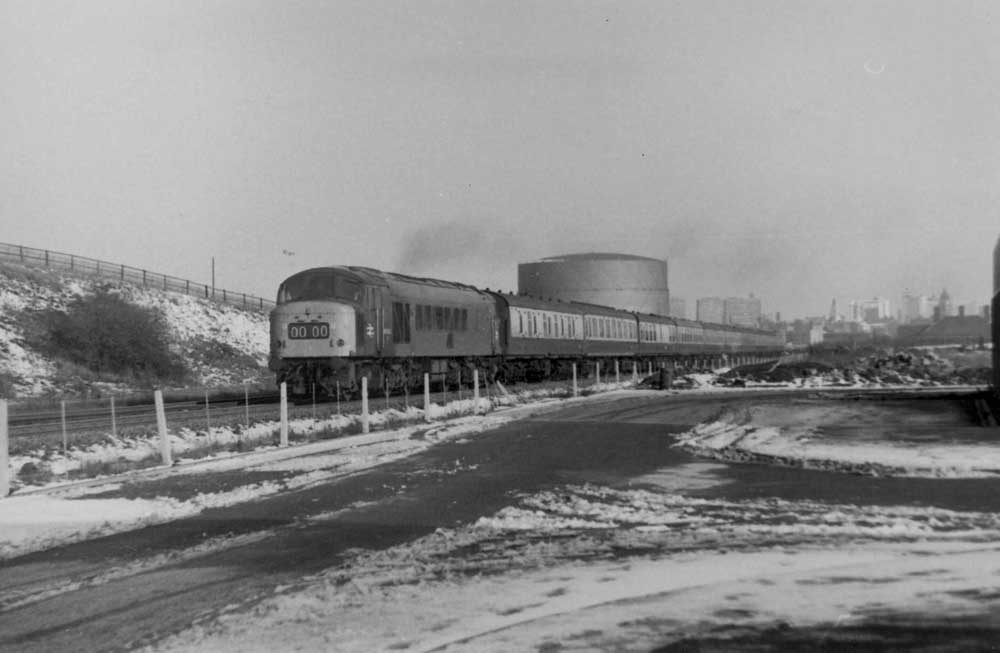
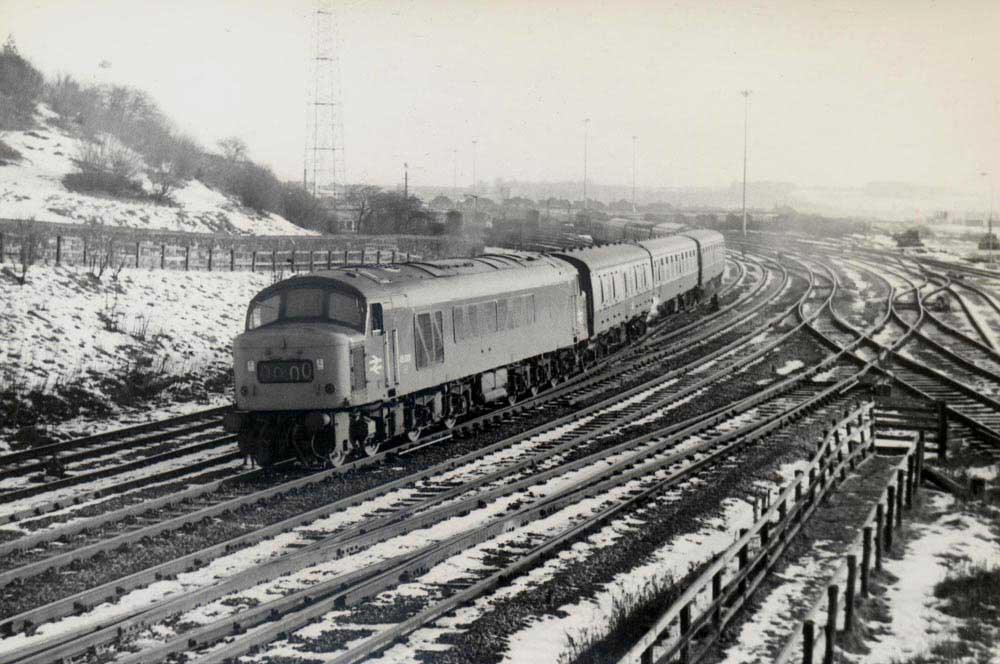
The snow (featured in the above views) lingered in places until at least January 27th.
February 10th saw torrential rain fall over parts of Scotland, leading to flooding in Fife and a landslip at Laurencekirk. Passenger services sustained delays of up to two and a half hours.
Heavy rain on February 19th/20th over south-east Kent led to an earthslip, closing the Wadhurst - Robertsbridge line for a week. Hastings line services were diverted via Ashford. Also impacted by the bad weather on February 20th was the line between Herne Bay & Margate, with engineering work heavily curtailed and a Class 33 sustaining cab damage when it was hit by a rail.
Heavy rains towards the end of February caused flooding of the Derby - Long Eaton line at Draycoptt, with about a mile of track affected. Severe speed restrictions were initially in place, but by February 25th the line was closed until the waters subsided.
On the evening of August 16th an intense storm affected north-west London, flooding the d.c. lines near Harlesden. For the next two days the d.c. services would run as far south as Wembley Central, where a connection was made with the main-line suburban services to Euston. Further south thunderstorms on the night of August 16th led to the closure of the Shepperton branch due to flooding at Fulwell. A Class 33/1 and a 4-TC provided service between Kingston & Shepperton.
Southern Scotland suffered from flooding on October 30th, with WCML services diverted via the GSW main line due to an underbridge being washed away at Wamphray. When the GSW mainline suffered flooding near Mauchline, the WCML service were then diverted via Newcastle and the ECML.
On October 31st strong winds caused damage to equipment in south London, including a signal gantry blown onto the tracks near Sanderstead.
Between November 10th & 15th strong winds accompanied by heavy rain with some snow & sleet affected much of the country. Four washouts occurred on the Furness line, two occurred on the Cambrian and areas of Southport & Warrington were impacted by floods. During this period WCML electric services were limited to 60mph. On November 11th the 22.37 Liverpool Central - Ormskirk service sustained damage at Walton Junction after striking a tree brought down by the winds.
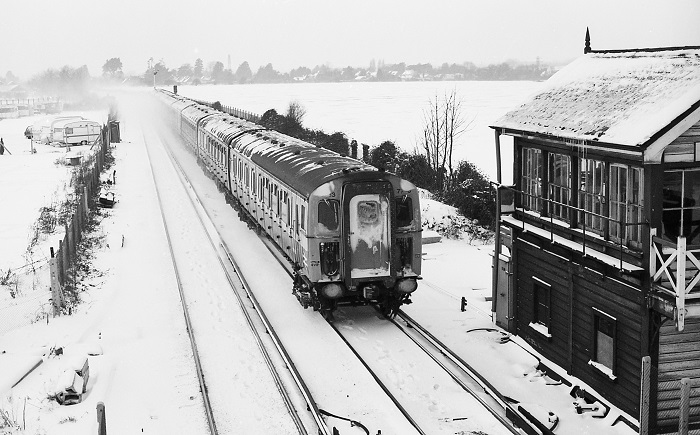
Widespread heavy fog on December 19th caused diversions and cancellations of many airline flights. London bound flights included diversions to Prestwick and Manchester. This resulted in the provision of at least seven specials to get the airline passengers to London.
![]()
1978 January proved to be a snowy month, particularly in the north, Glasgow received seven inches of snow on 3rd, whilst the Liverpool area sustained strong gales, this was the date for the opening of the Garston extension of the Merseyrail system, which operated with minimal weather related interruptions.
Severe gales on January 11th affected the South Western Division of the Southern Region with trees and debris blown on to the running lines at multiple locations.
Further snow fell on 11/12th in the north, whilst another storm followed on 18th. However it was the blizzard that began on the afternoon of January 28th, continuing into the 29th that really brought severe and life threatening problems to the Highlands of Scotland. The Inverness - Aberdeen line was the only one in the area to remain open. The down Clansman had reached Aviemore before being reversed and rerouted via Perth, Dundee & Aberdeen. Crossing the 17.40 Edinburgh - Inverness at Kingussie the Inverness passengers transferred to the Clansman , the 17.40 gingerly going forward as a local to Carr Bridge. A brave attempt to go further led to the train and its two Class 26 s becoming stuck, literally within view of Carr Bridge station. A rescue attempt by two locomotives also failed, the passengers off the 17.40 spending the night at Carr Bridge station. On the nearby A9 twenty motorists abandoned their vehicles for the safety of a cottage at Slochd. An engineers train also became stuck between Dalwhinnie & Dalnaspidal. On the Aultguish - Ullapool road a British Airways helicopter rescued twenty passengers from a stranded bus, whilst in Glencoe ninety motorists found haven in closed hotel.
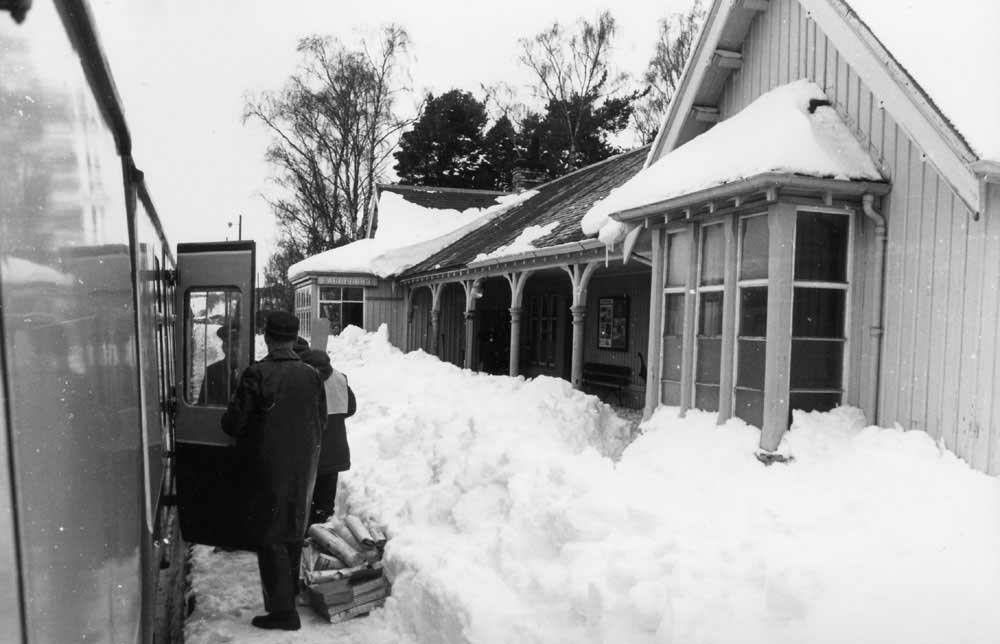
North of Inverness conditions were worse. The 17.15 Inverness - Wick/Thurso derailed the last five coaches after hitting a drift at Forsinard. This train had started out with 26037, to which was added 26039 at Helmsdale, this locomotive having worked down from Georgemas Junction in an effort to keep the line clear and to assist the northbound service The pair of Class 26 s and the undamaged leading coach were detached and proceeded forward only to become completely stuck in the snow at Altnabreac. Passengers on the train included a man with a broken leg and another recovering from kidney surgery. Judicious use of the fuel supply on the engines kept the carriage heated until the next morning, when the driver, Stewart Munro and second man James Forbes struggled through nine foot drifts back to Forsinard to raise the alarm. By late morning 26031, stabled at Georgemas off the previous day s freight from Inverness made an attempt to head south. It quickly returned to pick up a van, some volunteer staff and supplies for the stranded passengers. On this second attempt they reached to within two miles of the trapped train, allowing a young railway employee to reach the stranded passengers bringing hot soup. Once the exact location was known the seventy stranded passengers were eventually airlifted in six shuttles using an RAF helicopter from Lossiemouth and two commercial helicopters. They were operating in near white out conditions with the winds still gusting to 65mph.
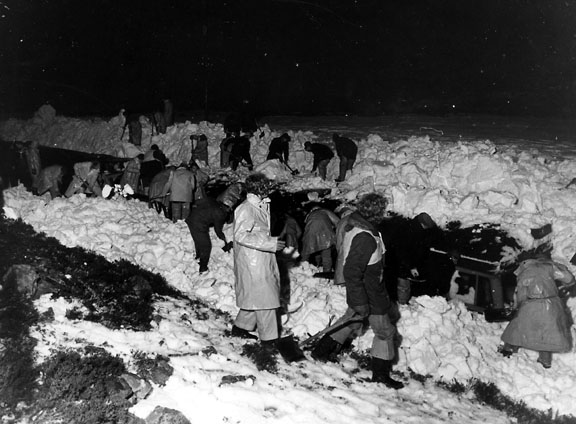
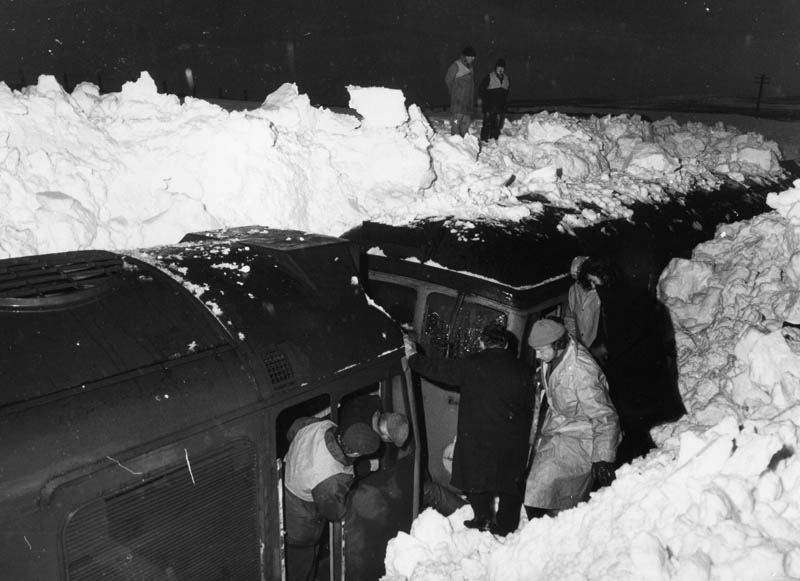
The above photographs show the challenging conditions caused by the snow near Altnabreac. For those unfamiliar with the line Altnabreac lies midway between Forsinard & Scotscalder, this section of line has no immediate road access making it probably the most difficult section to reach between Inverness and Georgemas Junction. Remarkably this view shows the locomotives and permanent way gang sent to clear the line at Altnabreac and rerail the five coaches. This view shows the aftermath of the locomotives and snowplough having charged the snow in the cutting. Although not obvious in the photograph the locomotive on the left is a Class 25, these were very rare on the Far North line. In trying to free the locomotives, much wheelslip occurred causing damage to the rails.
Update January 2010 - John Cunningham writes that his friend and neighbour from those days in Gillock, Ray Rand, may well be one of the workers in this photograph. He was a lineman based at Hallkirk, a big fella, about 6'3" with long blond hair, and I remember the pictures he showed me of him standing above the roof of the engine with his shovel.
Update December 2008 - Nevis Hulme recognised himself as the gentleman wearing the yellow waterproofs in the center of the picture. The notes below from Nevis detail recollections of the events of clearing the line! In front of Nevis in the photograph is fellow gang member Steven Brunton, I think. I remember going to the front of the engines to see what it was like and vaguely recall someone taking a photograph.
Nevis was working in the Dingwall permanent-way gang when, on the January 30th, we had word that we were to travel north ( on a p-way , i.e. permanent-way train) the following day to unblock the line and that we would be staying overnight. From Tuesday, January 31st to Thursday, February 2nd, I was with the gang at the blockage in the North. As we travelled north, I remember our Inspector, Douglas Landers, asking if he could sit by the window where I was. I was reading and not interested in the scenery unlike the Inspector. He had a background in tampers in the Bristol area to which he was drawn back after not too long in the Highlands. We stayed the two nights at the Braes Hotel in Brora along with the Tain, Rogart (?) and Dingwall gangs.
The work was around the 131 milepost north of Inverness, at the rock cutting which was filled with snow. I was one of the group sent on a mission on the Thursday to appraise the state of the track to the north. 1 miles beyond were four coaches with one coach beyond separated from the rest. The resistance of the carriages being dragged when derailed led to the buckeye coupling breaking. I cannot recall how many of the bogies of the carriages were actually on the rails. To the south of these the track was ripped to shreds, but I cannot recall and didn t note, for what distance from the carriages. We heard, at the time, that shortly before the derailment, the Guard had passed down the train to check that those passengers for Wick or Thurso were in the correct portion of the train. One passenger had passed over the connection between the two carriages when the train split between the first and second carriages. I don t recall where the engine was but think that it had been detached earlier. I have a recollection that we could see Altnabreac Station from the derailed carriages.
From his notes written at the time Nevis lists a number of issues that affected the handling of the whole incident. The order that they were written is telling of his priorities.
Prior to the derailment, we heard that the Helmsdale signalman had called for the ploughs but that this request had not been acted upon. (Possibly the snowploughs were in use elsewhere, perhaps on the Highland mainline?)
On site, an unserviced [I don t remember in what way], unsuitable mess van was provided with no competent cook and there was poor or no organisation of meals and breaks. We were fed an unbalanced diet. Norrie and Stephan, two of our gang, took over from two of the four cooks on the mess van and day-time food improved on the Thursday. It was a pity that they hadn t been available earlier!
We were stationed at Brora, some 1 hours from the job. The operation of servicing the engines was done in the morning at Helmsdale wasting the limited daylight hours. The ploughs were taken back to Brora every night and this meant extra shunting to join our train. There may have been operational reasons for these actions but they didn t make sense at the time. We were never on the job before 11.00 because of the servicing and travel required.
The ploughs were unsuitable for wet snow and the engines were not working in unison because of an auto cut-out on one. [I recall being told that as soon as one of the locos hit the snow, the engine cut out so losing power. This did not seem to apply to both locos but I m sure that someone can clarify this technical issue.] The experience that the ploughs couldn t break through and only became stuck, learned on Tuesday, was not acted on following day. The same error was made: the plough rammed the drift and became stuck; the men dug for a while then stood clear; the engines tried to pull out but this failed so we dug again and so on. It became clear how much digging was required but we were not left to do this. The result of this was wheel burns on the rails in the cutting which would require more replacement. Snow trenching of the drift, to aid cracking when the plough hit, was not tried. [Old hands must have made this comment.]
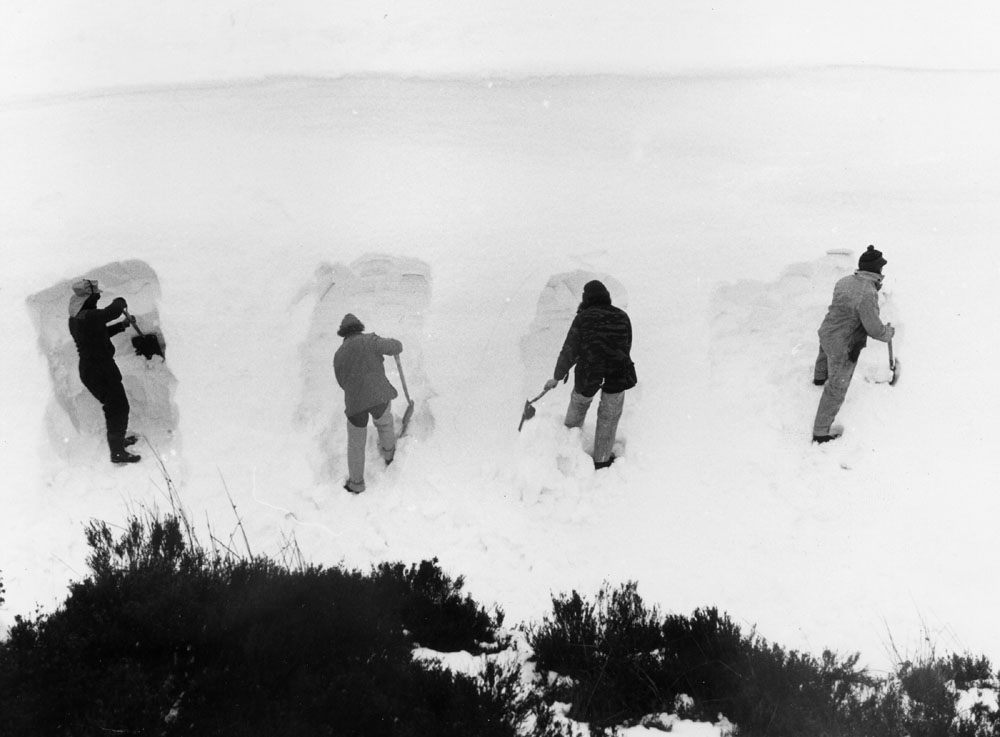
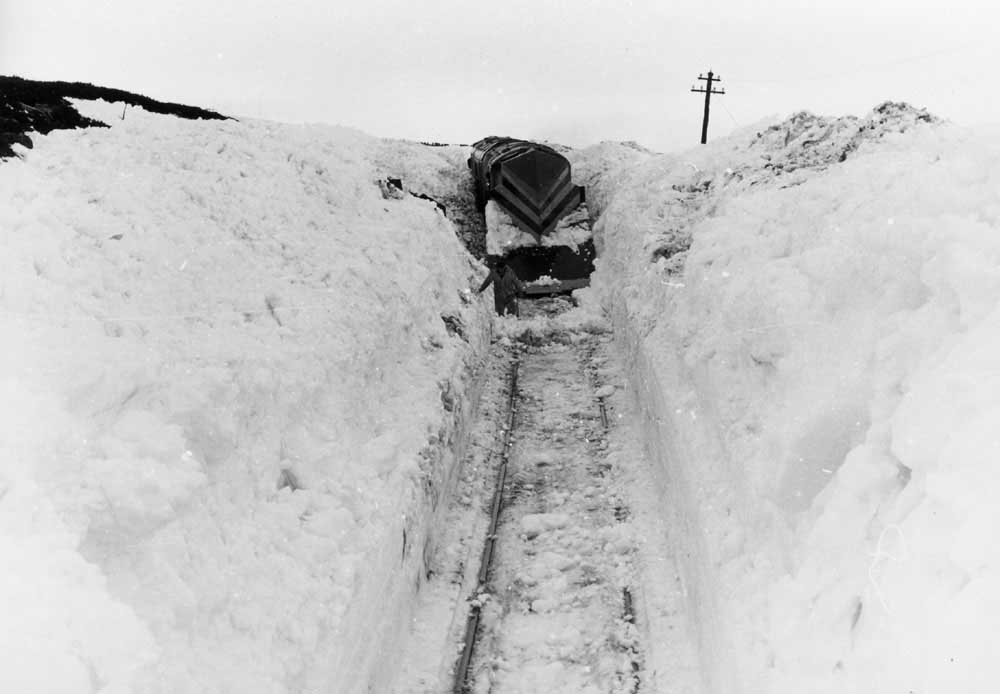
At some point in the operation the rail mounted snowploughs were removed from the operation and a Hymac digger was brought in using one Class 26 and a flat bed wagon to work on the snow clearance. The three views below feature this part of the operation.
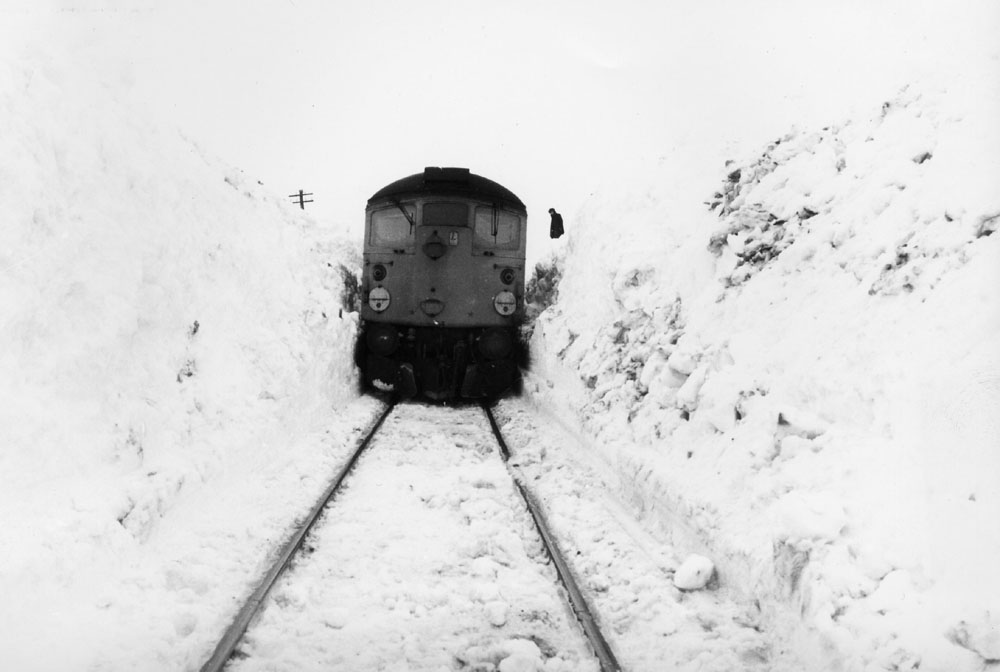
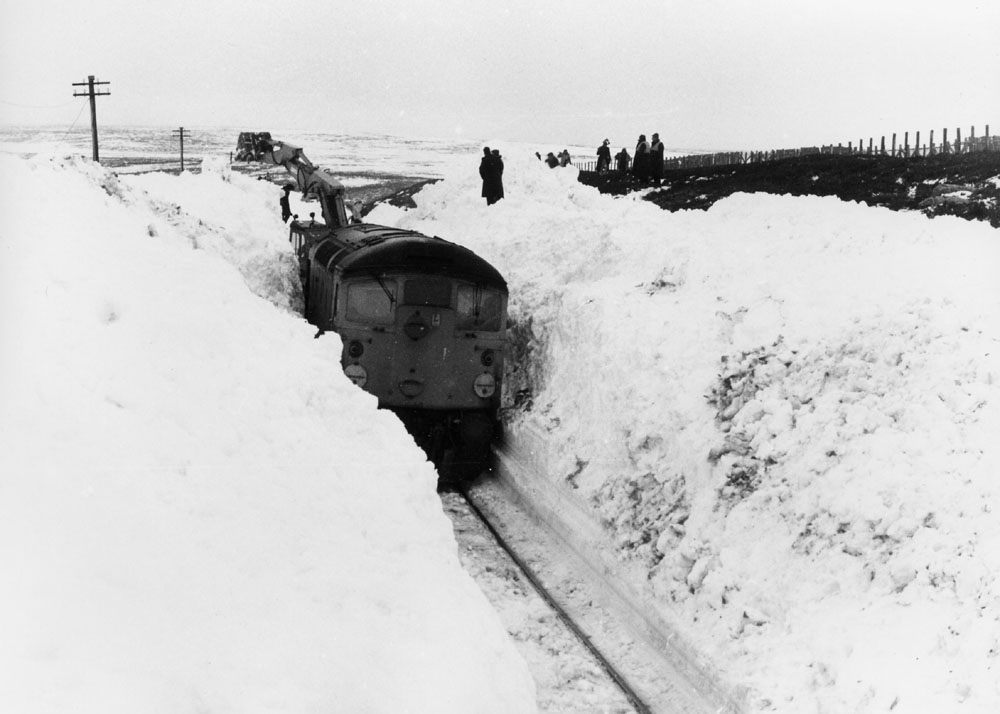
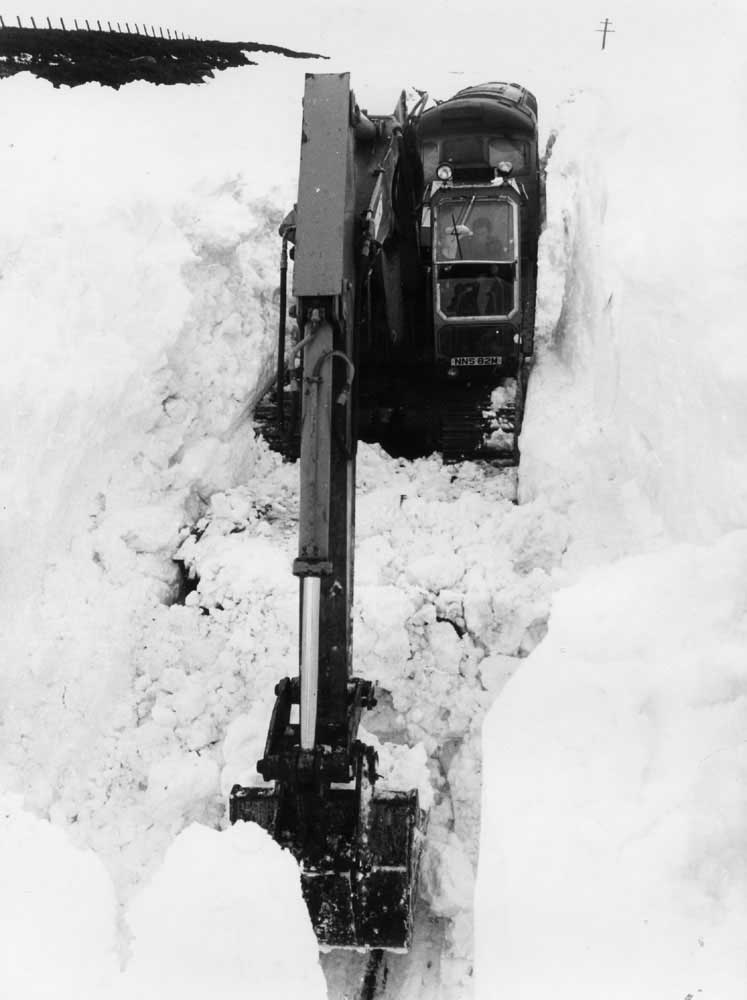
There appeared to be no co-ordination of the operation with no-one in charge [or so it seemed!]. There was a lack of precise instructions to men [e.g. when the engine was going to attempt a move] and a lack of confidence in authority. Management [ men from Perth , I was told] were even getting in diggers way. [I think that my life-time interest in health and safety stemmed from all that I witnessed when working on the railway!]
A Hymac on a low loader was brought in to open the cutting. If left to the task all day and night it could have broken through. Alternatively, if left to it, the men could have dug out the cutting in the time. [I cannot recall when the Hymac was brought in but it must have been out of the way on late Thursday afternoon because I noted that the plan to go home on Thursday was delayed. I was only home at 12 midnight after a fruitless use of the plough.]
The following day I went to work at Dingwall at 09.00 rather than the usual 07.40 because of the rule of being allowed nine hours rest.
I returned to the north on Sunday, February 5th and remained there until Tuesday, 7th. By starting at 05.00 on Sunday morning, and although the train was late, we arrived at the site the earliest yet (and, as it turned out, ever). The cutting was open and work on all three days was on relaying the track. The re-railing of the carriages was interesting: as one coach was dragged on using wedges, rather than using the crane on site, it tilted badly. Some of the rerailing gang had to dive clear into the snow of the embankment but all was well. The weather was cold with drizzle but meals were good with Richard and Norrie, of the Dingwall gang, and two others in the mess van.
With thanks to Nevis Hulme for the above notes & memories, recalled from events which occurred over three decades ago.
Update to the above text January 2011
Steven Brunton writes that it is myself in the picture with Nevis Hulme. As we remembered it certainly was a crazy time up there. I do remember a couple of instances of our time there. For at least one of the nights in the Braes Hotel there was no power, luckily they had plenty of candles on hand and they did supply us with a hot meal. I was bunked in a three-bed room with Norrie Maclennan and Dougie Taylor and we were so cold (as there was no heating in the hotel) we just took our boots off and went to sleep with our clothes and jackets still on to try and get warm.
I did end up in the mess car as one day I was walking past the Inspector and he caught me by the shoulder and felt how wet my jacket was and told me to go there to dry out, later that day Norrie was also sent in to dry out. As far as I recall there were two guys from another squad doing the cooking and to be honest the food they were giving out was a disgrace, one slice of bacon in a roll with a cup of tea was all they were dishing up and considering the conditions we were working in something should have been said or done. Myself and Norrie went through the mess car (it was an old black kitchen car with gas griddle and oven) where we came across a compartment stacked with food which included bacon, eggs, large tins of beans, rolls etc. We started bringing it all through and set about the cooking. On the next break the guys were asking us where were we getting all of this stuff and we said 'through the back, there's mountains of it back there' so the boys all went to see the Inspector to insist that we stayed and did the catering from then on and although we were by no means 'cooks' we at least saw to it that the boys got a good meal when they came in.
By Thursday the line south of Helmsdale was cleared for traffic, it would not be until the following weekend that the derailed coaches would be dealt with. The Highland mainline remained closed until Tuesday, the Clansman continuing to be diverted via Aberdeen due to the Class 47 s not being snow plough equipped and to prevent snow ingestion into the coaches airconditioning systems.

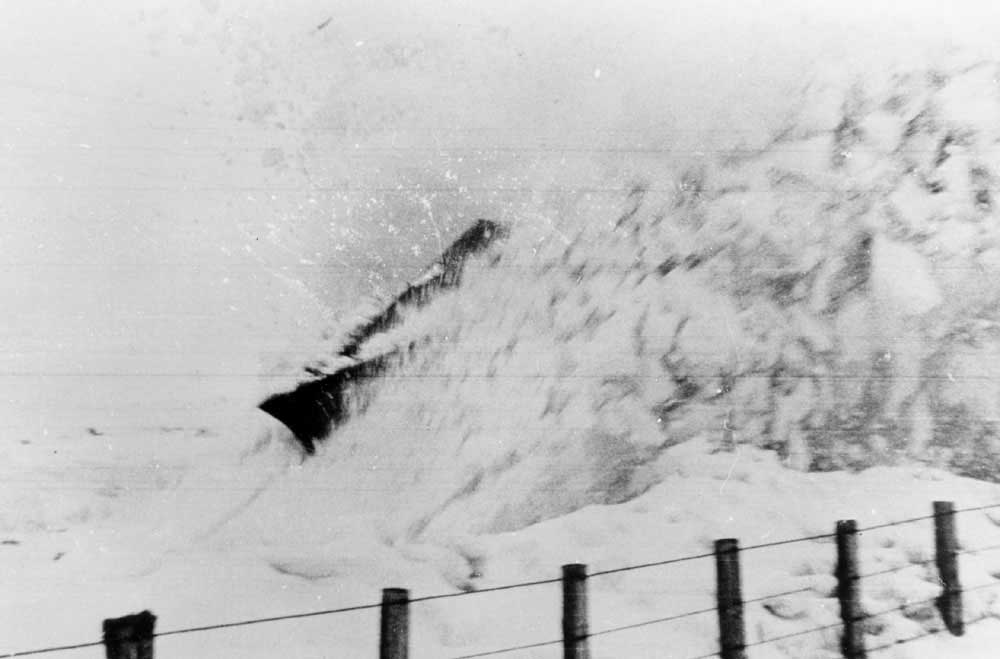


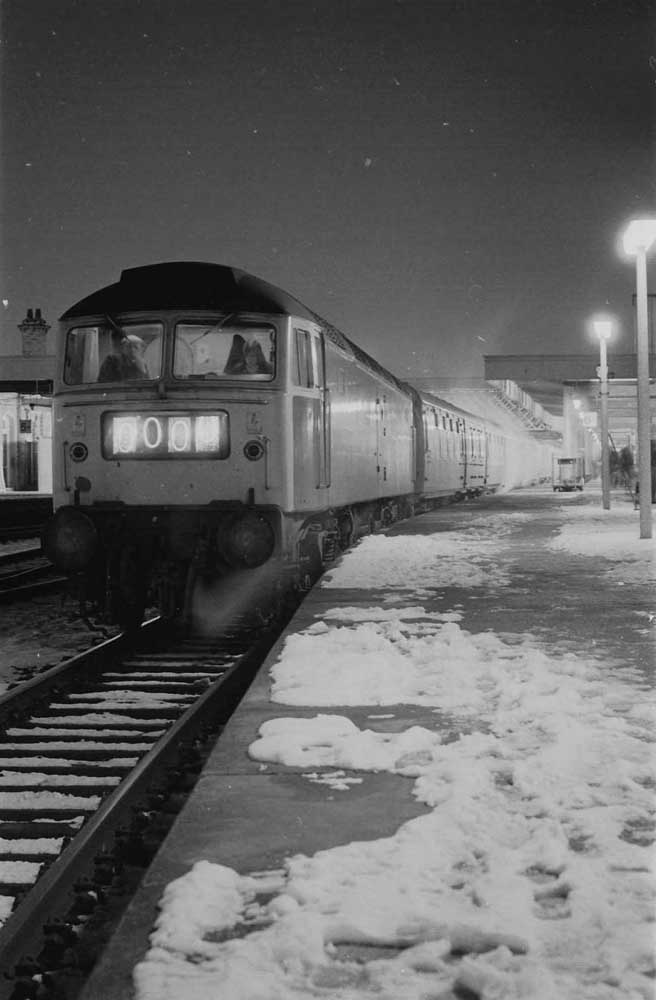
On February 14th 37042 with two large snowploughs was in use between Middlesborough & Whitby. Near Great Ayton both snowploughs derailed, damaging much track, the local passenger service was disrupted, the line being reopened on February 22nd.
Heavy snow fell between February 18th - 20th with the south & west bearing the brunt of the storm. Fourteen inches fell at Exeter and Cardiff with snow drifting to 25 feet on Dartmoor and Exmoor. By mid afternoon traffic was seriously disrupted west of Bristol. The 14.40 Leeds - Plymouth was cancelled at Taunton, the 16.30 Paddington - Plymouth picked up those passengers, and was noted passing Newton Abbot at 01.30am! Exeter made use of steam lance equipped 45065 to free numerous points in the area.
Update - Mr Rodney Crook writes that as a member of the Signal & Telecoms section at Exeter, he had been assigned to snow clearance at Exeter St Davids. They were advised a locomotive would be waiting for them to assistance in clearing the points. A westbound overnight parcels train hauled by 45065 was sitting in Platform 1, unable to proceed west due to the worsening conditions, possibly affecting the seawall section at Dawlish. The driver fired up the boiler whilst a steam lance was acquired from under the West Signal Box.
A number of points were cleared at St Davids before heading up towards Exeter Central and out to Pinhoe. Here the snow was up to the platform level. Despite the doubts of the S&T staff the locomotive made good progress through the snow, the driver seemingly knowing his charge well. Regrettably the day's proceedings were terminated when the boiler water became exhausted!
The snow eventually closed the Westbury - Castle Cary - Taunton line and the Barnstaple, Exmouth & Okehampton branches, the latter remained closed for almost a week. Out of Westbury the Salisbury and Weymouth lines were also closed. At Warminster a diesel multiple unit became snowed up, the passengers being housed in nearby accommodation for the night. A Deltic to Devon , Paddington - Bristol - Kingswear special with 55018 on February 19th was turned round at Bristol due to the worsening conditions. On February 20th Finsbury Park based 31101 & 31202, with snowploughs cleared the Barnstaple and Exmouth branches. Also on this date (20th) a diesel multiple unit became snowbound at Chard. The heavy snow in the South Wales area had prevented any services running in the Tondu area on February 20th.
From the notebooks of Sean Greenslade with regard to the Exeter area February Sat 18th & Sun 19th
Stock off the 1V17 Waterloo - Exeter still in the station? arrived about 23.45, the Class 33 went out to the bridge (west end) and remained there for two hours since the route could not be set, later eventually retired to stabling point, 45065 would eventually push the stock out to Middle Box.
1B40 18.30 Paddington Plymouth with 50028 arrived shortly after midnight (140 minutes late).
1B58 20.30 Paddington -Plymouth arrived about 00.38 (70 minutes late).
45065 departed stabling point shortly after midnight with steam lances, worked on points by West Box for two hours.
1B79 18.08 Penzance - Bristol 45xxx (150 minutes late).
1B52 21.20 Bristol - Plymouth 31210 & 46028; 31210 added at Taunton, miniature snowploughs fitted, removed at Exeter St Davids, booked 23.06, train still present at 03.16am Sunday morning.
6O19 16.20 Penzance - Morden milk 47248, booked 21.18, actual 02.02 (Sun).
2B95 22.00 Exmouth - Exeter St Davids 51578+59580+51587, booked 22.30, arrived 02.28 (Sun), stuck at Central for about 150 minutes due to ex-Waterloo stock trapped on Platform 4.
2B95 22.48 Exeter St Davids - Exmouth 51578+59580+51587, delayed due to frozen points, did not leave until 03.16am (Sun).
1V19 19.00 Waterloo - Exeter 33005 booked 22.50, actual 05.03 (Sun), stopped at Exmouth Junction 03.23 (Sun) until 04.58 (Sun) whilst points were cleared.
February Mon 20th
31106 & 31202 with two fullsize snowploughs cleared the Barnstaple branch, late in the afternoon they set out to clear the Exmouth branch, which was closed up until this point.
Main line service began running on Monday but subject to many delays, things improving on Tuesday for mainline services but local branch services were still spasmodic.
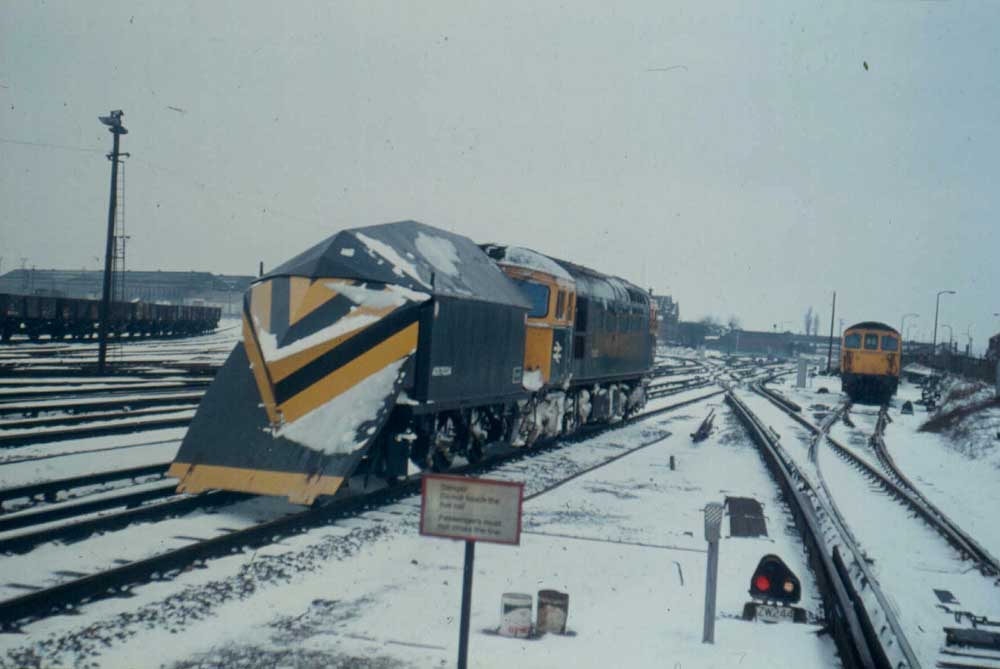
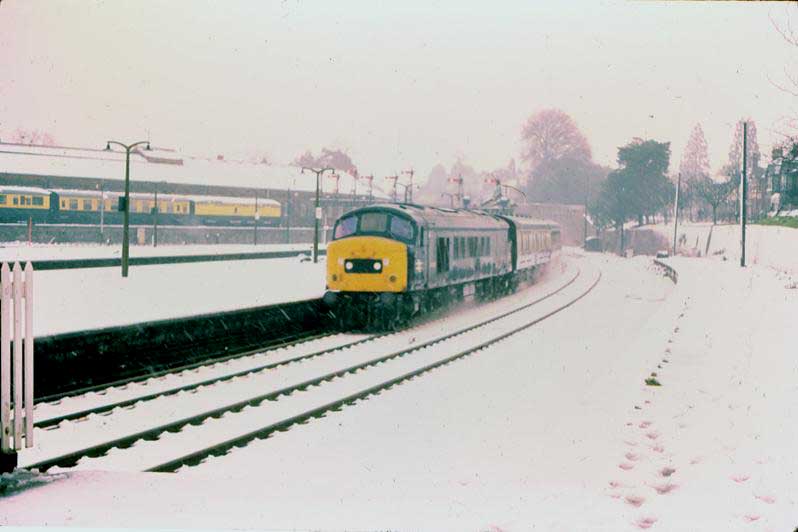
On the Southern the 19th saw the Bournemouth - Weymouth main line and Lymington branch closed because of snow, service not being resumed until the afternoon of 20th. Further east snow on 16th & 17th affected the coastal services, with the 05.15 Brighton - Portsmouth Harbour reaching its destination five hours late. Diesel haulage was resorted to on routes coming out of the south coast towns. In addition electric units were strengthened simply to apply brute force to the problem. By February 23rd a thaw had set in with flooding now becoming the problem! Also on 23rd severe gales in the English Channels caused delays to the Boat Train services at Dover from Ostend.
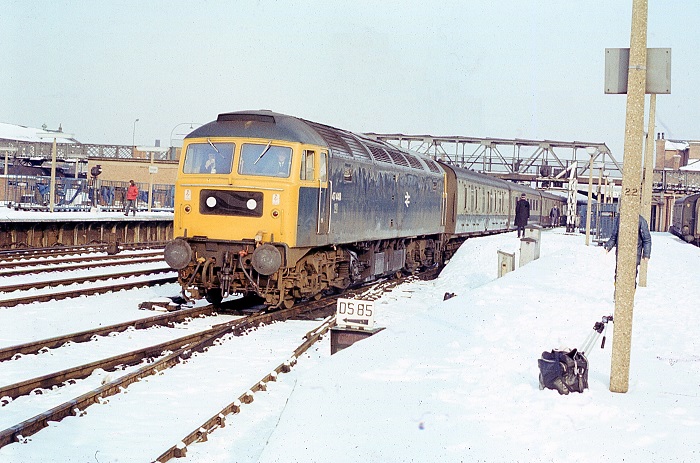
The lines out of Liverpool Street were bedevilled by several factors: the cold weather, heavy demands on oil traffic from the local refineries and the simply bizarre, permanent way work in the Bethnal Green area had raised track levels leading to the banning of those Class 37s with roof mounted horns (37118 upwards)! Electric traction on the Liverpool - Southport services were affecting by freezing rain on February 21st.
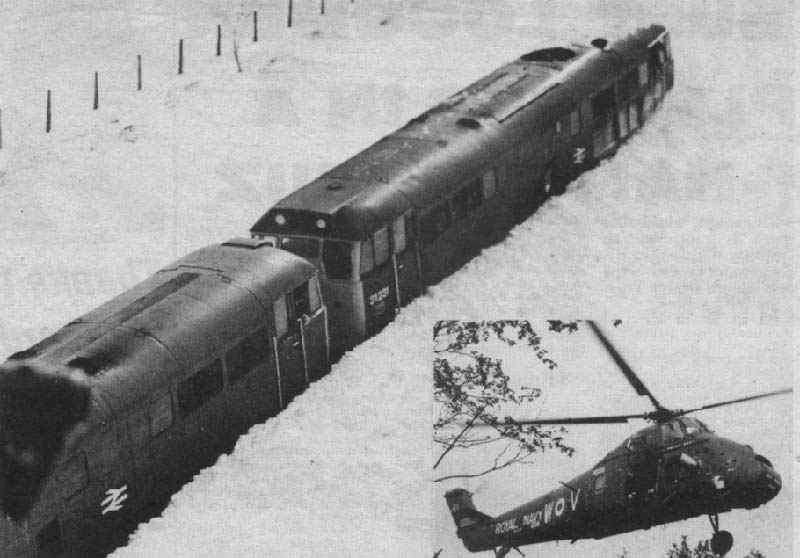
By February 23rd a thaw had set in but substantial amounts of snow would remain in many locations for a further week.
A violent thunderstorm in the Cheshire area on the evening of May 4th including lightning. One lightning strike hit 25070 at Greenbank. The locomotive & crew were unharmed but much damage was caused to the lineside signalling equipment and the operation of the track circuits.
The early morning of October 31st produced high winds in the south London area, being strong enough to bring down part of a signal gantry in the Saunderstead area, causing delays to several services.
Between November 11th & 15th the country suffered from extremely high winds accompanied by heavy rain with some snow and sleet. Coastal damages included four washouts on the Furness limne and two on the Cambrian line. Flooding was experienced in the Southport & Warrington area. On the opening day of the storms (Nov 11th), a tree weas blown into the path of the 22.37 Liverpool Central - Ormskirk at Walton Junction. The driver was injured and the leading vehicle (29886) damaged. On the Southern Region on 14th a tree was blown down on to the Lewisham - Hayes line at about 6pm near Catford Bridge, interrupting rush hour services.
Freezing conditions in the early hours of November 29th affected much of Kent. Primarily a mix of rain & sleet turned to ice as it hit the conductor rails. At least one early morning Victoria bound rush hour service froze to the rails at Pluckley, taking assistance from the following service. Other services required locomotive assistance, whilst others tried combining units was not successful.
On December 1st 47435 working the 13.21 Liverpool - Plymouth stalled at Dawlish whilst departing, possibly due to the very heavy seas running at the time. A Class 47 was sent from Newton Abbot to assist, leaving the passenger train very exposed to the ocean elements for about an hour. The heavy seas eventually swept away much of the ballast on the down line, which required single line working between Teignmouth & Dawlish Warren for three days.
Icy weather on December 2nd saw many football matches cancelled, with the consequent cancellation of many football specials. The cold weather did not deter a number of shoppers specials from operating.
The year closed out with bad weather in the Midlands and North East. Walsall station, as usual, was flooded after torrential rain on December 29th. Heavy snow over the New Year plagued services with delays whilst faulty equipment made life even more difficult to maintain the timetable. In the West Country with temperatures reaching down to -13C many things simply froze up, Exeter proved to be a graveyard for frozen up equipment, with eighteen locomotives awaiting a thaw including 25052, 25206/225/263, the only operable machine being 46020, which had been equipped with steam lances for the freeing of pointwork and rodding. The local services out of Exeter were cancelled due to the diesel multiple units being frozen solid. The 31st's 00.05 Paddington - Penzance was reported eighteen hours late at Plymouth, 50046 had failed at Brent with 47106 sent to assist, the service was terminated at Plymouth. Penzance passengers went forward on the 10.30 ex Paddington, itself running eight hours late. The Penzance passengers off he 00.05 service had a journey time of 25 hours. Many Western Region cancellations continued over the New Year, with heavy delays to services that did run. Lines blocked included the Salisbury - Exeter and Weymouth - Castle Cary.
Heavy snow had begun to fall during the evening of December 30th in the Exeter area, the precurser of several days of very cold, wintry weather. That night the 2B95 22.48 Exeter St Davids - Exmouth multiple unit was cancelled due to snow blocking the points at Exeter West. It was also reported the the 1B79 18.08 Penzance - Bristol was stuck in a snowddrift at Largin. A special train ran in its place from Plymouth but only reached Lipson Junction before it too became stuck in a snowdrift.
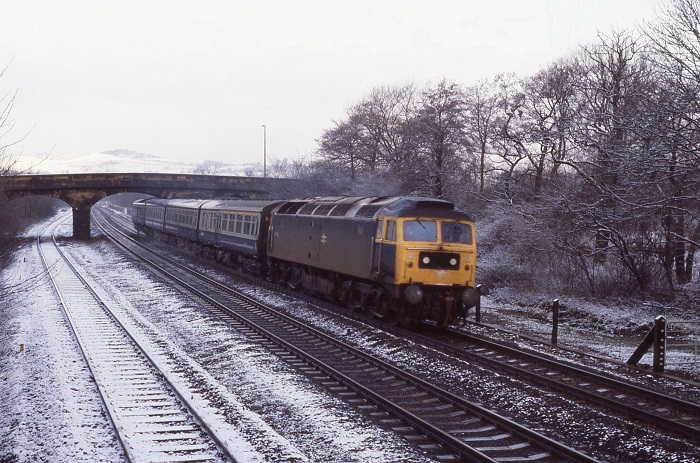
On the SR heavy snow fell on December 30th & 31st causing many equipment related failures especially snow blowing into the electrical equipment and the seasonal problems of shoegear failures on the Bournemouth line REP units. The Lymington branch was closed, on the Isle of Wight only the line in the Ryde area saw services, whilst commuter services out of Waterloo dwindled as the afternoon of December 31st wore on.
The GE lines faired no better, heavy snow disrupting Thornton Fields carriage sidings, causing considerable stock disruption. This resulted in the 10.30 Liverpool Street - Norwich running with a six car diesel multiple unit of Derby/Cravens units, without toilet facilities which required extended station stops to be made. The Shoeburyness - Pitsea line had snow two feet deep on December 30th, being cleared by the Stratford plough on New Year's Day.
In the Merseyside area heavy icing on December 30th led to the use of Merseyrail's Battery Locomotive propelling the 05.17 Birkenhead North - West Kirby, followed by the 08.06 West Kirby - New Brighton. The morning's first Southport - Liverpool Central service suffered over two hours delay and was joined by the following service which had been cancelled to passengers but joined up with the first service to hopefully overcome the icing issues. Likewise in the opposite direction the 06.05 Liverpool Central - Southport was made up of nine vehicles instead of the usual three!
Late on the 30th the north London area was impacted by heavy snow, affecting long distance services. An early morning northbound newspaper train from Euston was cancelled.
In Scotland on a very wintry December 30th a points failure at Greenhill Lower Junction delayed two early evening Glasgow bound services, one from Aberdeen and one from Dundee. The two trains were delayed overnight with the crews able to provide heat and hot drinks and snacks throughout the night. Passengers from the Dundee train joined those in the Aberdeen train, with the latter eventually reaching Glasgow Queen Street about 8am the next morning.
![]()
1979

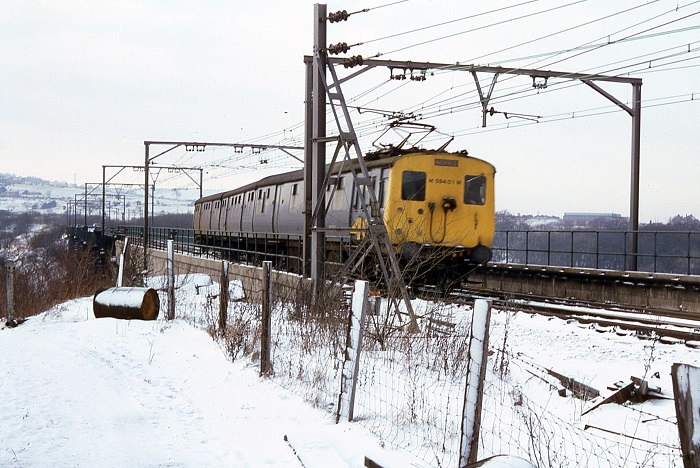

January 20th 1979
January 20th 1979 certainly dawned bright, but it wasn't clear. In throwing back the bedroom curtains all was revealed, a thick blanket of snow lay everywhere, with the great chance that more would fall by the end of the day. And best of all it was a Saturday and I had no plans.
Now it always seemed to me that snowy days only occurred on a weekday, when school or work usually intervened over 'checking out the trains', which I now realise was a terrible mistake to make. But here was a golden opportunity to make the most of this snowy day. After getting properly kitted out with all the finest snow gear available we trudged off to Derby Midland to see what was happening on the railways.
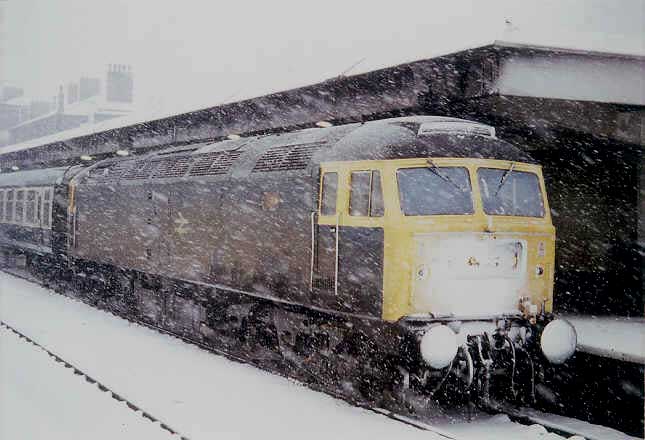
Our arrival at the station was marked by a return of heavy snow showers, which clearly form part of the above picture featuring 47468 on a northbound NE/SW service. My notebook indicates that close by was 45116 which had just been declared a failure possibly on a London service, the exact details are now lost in time. From the vague recollections of this day there were no other spotters on the station at this time, or if there were they were bundled up in either the waiting room or buffet.
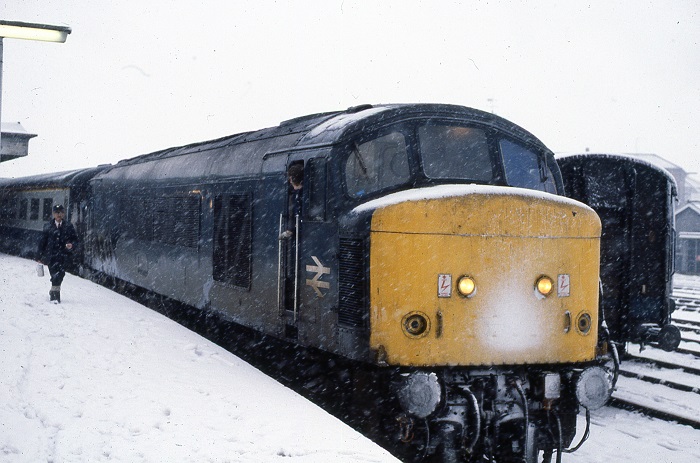
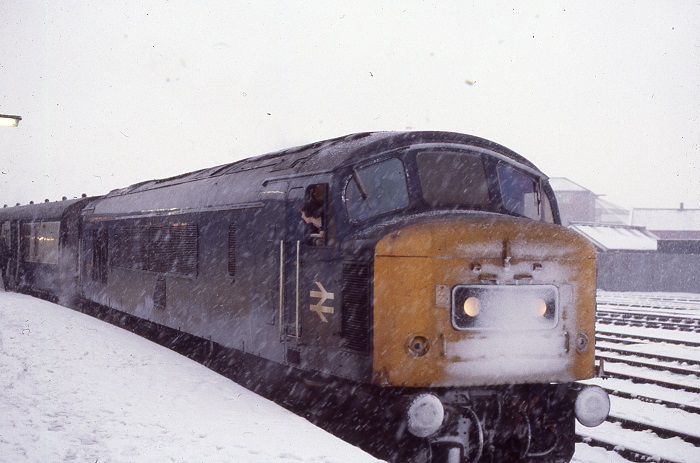
As the morning wore on and my resemblance to a snowman became more acute I was approached by an equally intrepid soul who inquired if I would be interested in a visit to Derby Works & Toton for a modest fee. Apparently an NREA trip had lost many of its intended participants because of the inclement weather. The possibility of being stuck in a snowdrift on the A52 was of no consequence compared to the vast array of motive power that might be seen in blizzard like conditions. So we set off for Toton, with thoughts of Captain Scott or Ernest Shackleton and more importantly would we have enough film for the day? Wisely the intrepid bus driver did not venture off the main road at Sandiacre obviously feeling that if we wanted to emulate Captain Scott we'd better walk the rest of the way past the cement depot and under the A52 into Toton depot.
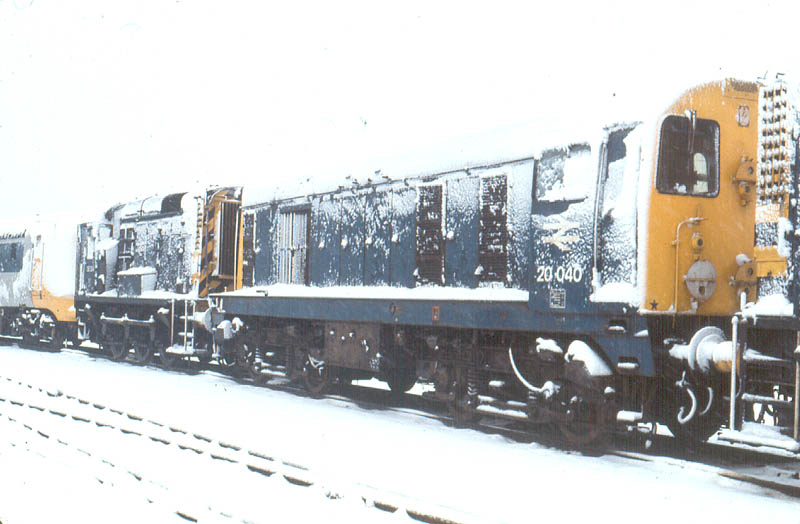
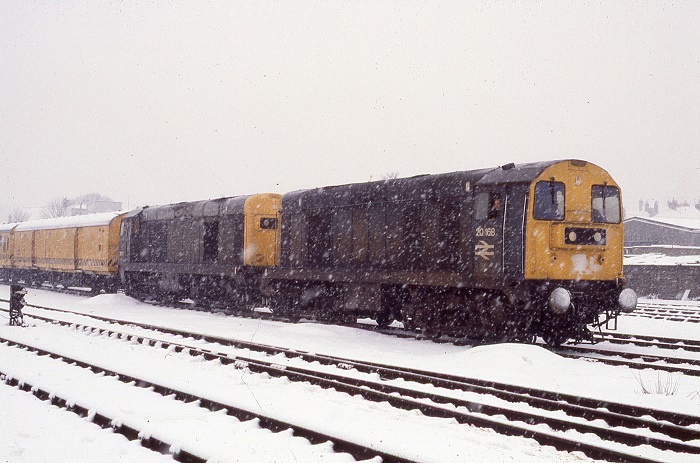
The snow was no longer falling as we left the bus and made our way around the Works, which as you can see from the views below were well coated with a good layer of snow. Which made navigating the yards a little tricky with the snow covering up many an item just waiting to trip you up!
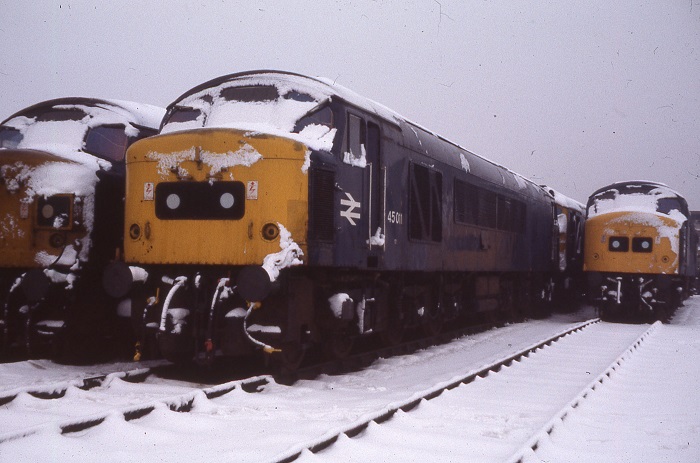
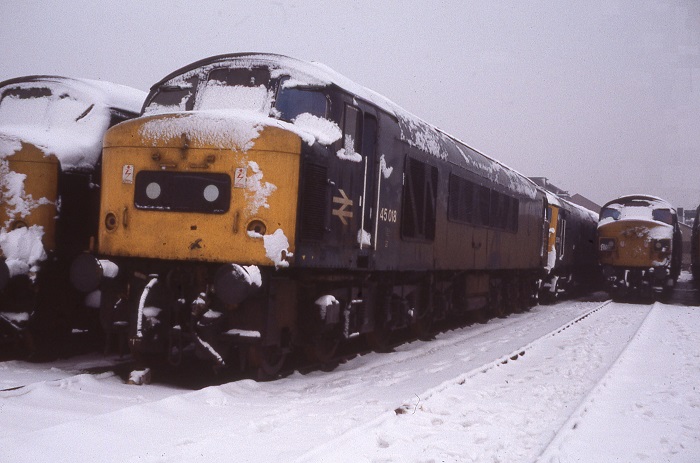
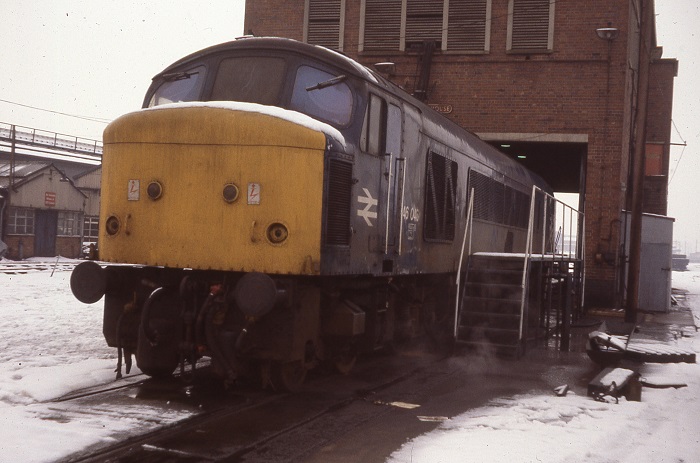
The revival of these memories from a snowy January day in 1979 led to the usual researching of materials to look for other times of snowy weather as it affected the railways - the notes below just scratch the surface of those wintry moments on the railways.
As the New Year opened much snow still remained on the ground from the December 30/31st storm. More heavy snow fell on the north west & Midlands on January 2nd with the Channel Islands getting a heavy fall on 4th.
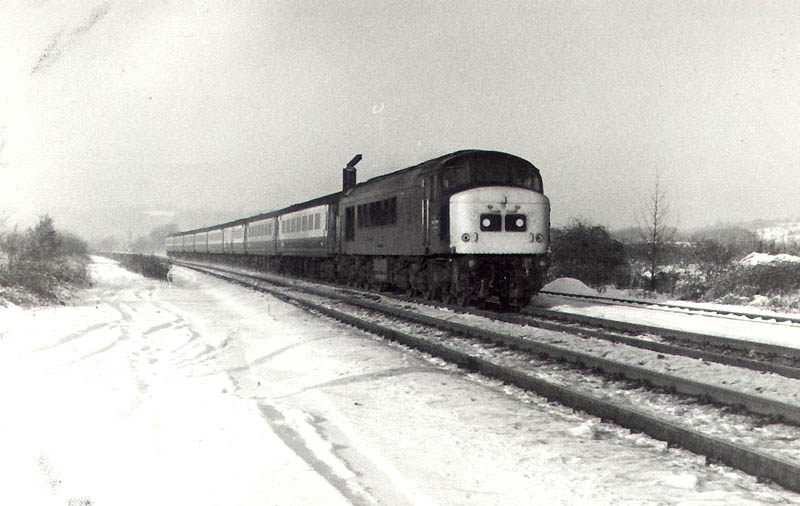
Heavy snow over the New Year plagued services with delays and faulty equipment making life even more difficult to maintain the timetable.
In the West Country Exeter proved to be a graveyard for frozen up locomotives, with temperatures reaching down to 13C most things simply froze up. At Exeter the local services were cancelled with the diesel multiple units frozen solid. The diesels fared little better with eighteen frozen up locomotives including 25052, 25206/225/263. On January 1st the 1B02 00.05 Paddington - Penzance arrived with 50034? about 215 minutes late. The locomotive was taken off at Exeter and taken to the stabling point to top up the lubricating oil. At this point the engine would not start, it would take about 45 minutes of effort to get the locomotive running, it then returned to its train and worked forward. Set P317 worked the 08.46 Exeter St Davids - Barnstaple, by the time it returned to Exeter with the ex-10.10 only one coach heater was working and one coach was filled with fumes. 33018 and coaching stock continued the diagram, all other locomotives were inoperable in some way.
At about 2pm on a very, very cold January 2nd Exeter stabling point contained 08288, 08641, 08953 (station pilot) 25052, 25206, 25225, 25263, 31107, 31138, 33009, 33114, 46020, 47008 & 50022. Most of these locomotives were unserviceable, either unable to start, or unable to heat a train. The diesel multiple units were in equally poor condition. Set P464 had been obtained from Newton Abbot to work the Exmouth branch on a go-when-ready basis. At about 7am 46020 was sent from Laira to Exeter equipped with a steam lance and carrying a fitter and an electrician. Later in the day when the 'Golden Hind' failed at Brent 46020 went to its rescue, taking it as far as Newton Abbot. All the trains passing through Exeter were standing room only. 47008 had arrived with empty coaching stock from Newton Abbot to work the 07.15 to Plymouth, whilst waiting to depart the brake gear on the locomotive froze solid.
For the SR much of January was a miserable time. Strong winds during the first week of January created deep snow drifts in parts of Kent, the first services over particular routes required the passage of a snowplough. Trackwork that was not freed from snow could produce derailments, such as 4-CEP 7172 becoming derailed at Minster South Junction on the morning of January 4th, it would take a day to rerail the coaches and repair the track. January 2nd found the Central Division reduced to a shambles, snow and ice coupled to equipment failures and crewing issues demolished the timetable. The next day a severe frost and a guards strike at Selhurst involving ice on electric multiple unit footboards incapacitated local services. On the Western Region a morning Twyford - Paddington service with 50027 suffered frozen brake gear at West Drayton & Acton, 31117 eventually came to the rescue. In Scotland there was snow on the ground at sea level elevations, beginning at least January 10th.
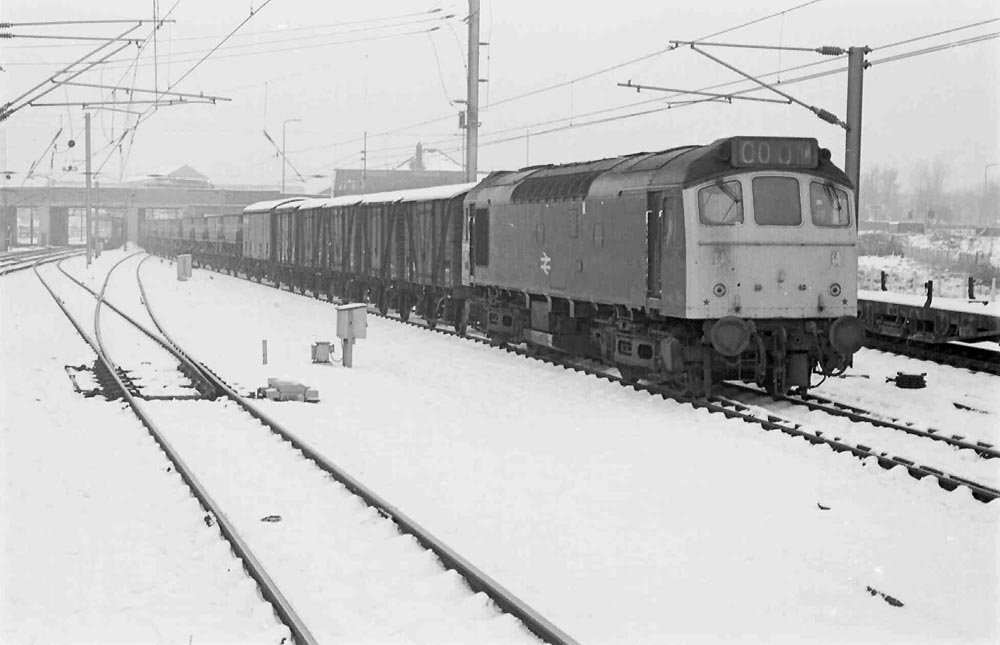
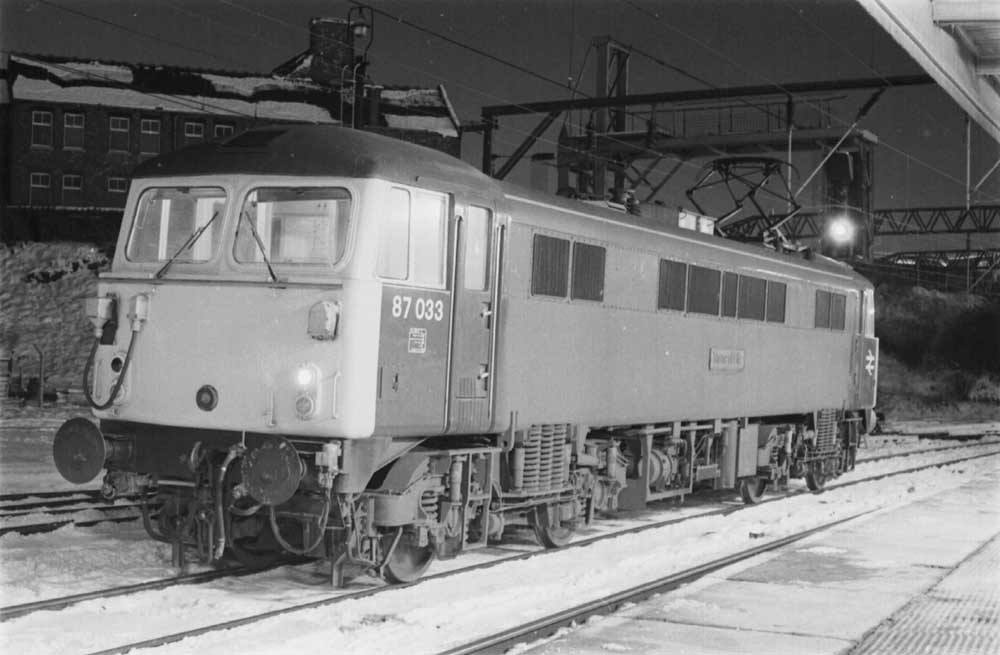
On January 4th & 5th high tides damaged the lines along the seawall at Dawlish, leading to a bus service operating between Newton Abbot & Exeter until the lines could be repaired. Several diesel multiple units and 08288 & 08641 were taken from Exeter stabling point to Exmouth Junction to have repairs made to brake pipes damaged in the freeze-up.
As a result of the challenges experienced north of Inverness during early 1978, from January 8th all brake vans operating out of Fort William, Inverness & Oban were equipped with supplies to accommodate fifty people for upto fifteen hours. The emergency survival kits provided food & drink items, blankets, lighting and heaters.
The South Western Division of the Southern Region saw unofficial strike action on January 10th affecting the majority of the Division's depots. Also on January 10th an unofficial driver's strike at the Southern's London area Central Division depots caused major operating difficulties at the London terminii.
On the Eastern Region, Liverpool Street Division the heavy snow falls affected punctuality, not helped by overhead line trouble at Stanway on 14th, a broken gas main at Wickford and a landslip at Mistley on 15th. Both the Colchester snowploughs were in use on January 14th & 15th. A railtour operating between Liverpool & Doncaster on January 17th noted freezing conditions, snow and fog in the Liverpool area but by Manchester conditions had greatly improved. The Woodhead route quickly brought the return of ever deepening snow, with the nearby reservoirs partially frozen over. East of Woodhead tunnel the snow was much deeper, snowploughs were in use with much manual labour being used to free up pointwork. Dropping down into the Sheffield area the quantity of snow decreased.


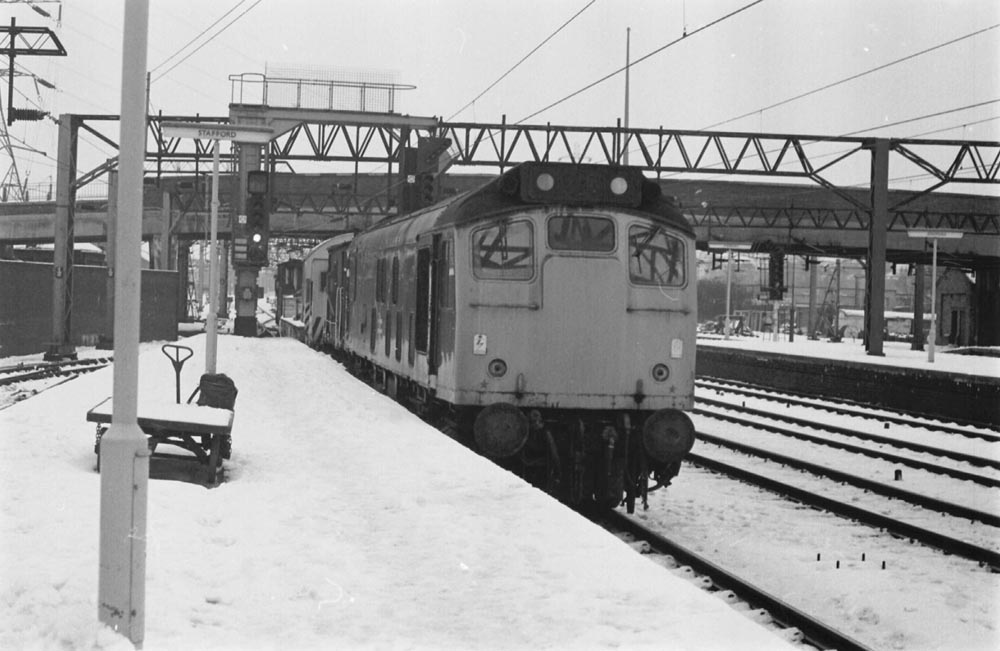
As if the weather was not enough of a problem, multiple ASLEF one day strikes did not help matters, with January 16th & 18th being two of those days. On strike days no de-icing trains were run.
Snow returned on January 23rd, coupled to the freezing conditions meant grief for the electric units. Continuing ASLEF action compounded the passengers woes, especially their inaction on 23rd which allowed heavy ice to build up since no de-icing trains were running. The next day saw most Central Division electric multiple unit services cancelled unless a locomotive was available to assist, a most unusual sight was 31114 & 73002 assisting an 8-SAP formation on a down Brighton train, the Class 31 being removed at Redhill. Much stock disruption occurred, making a return to normal working even more complicated. As each day wore one more electric services operated but following no particular timetable. Icing had heavy frosts each night would then cause the daily process to repeat.
On January 24th the 05.13 Staines - Windsor froze to the rail between Ashford & Feltham. A Ripple Lane - Earley tank train surrendered 37215 to assist the stranded train, taking the twelve car working to Twickenham where the emu's struggled on alone to Waterloo. January 26th also brought heavy icing and major problems, it would not be until the 29th that conditions would ease. On the SE Division similar problems were encountered, especially on the North Kent lines with ice and snow requiring diesel power, especially on those days after the ASLEF stoppages.
On Saturday January 27th 45054 was noted at Stratford - on - Avon with a day excursion, the locomotive's boiler was not working, leaving the coaches with ice on the windows.
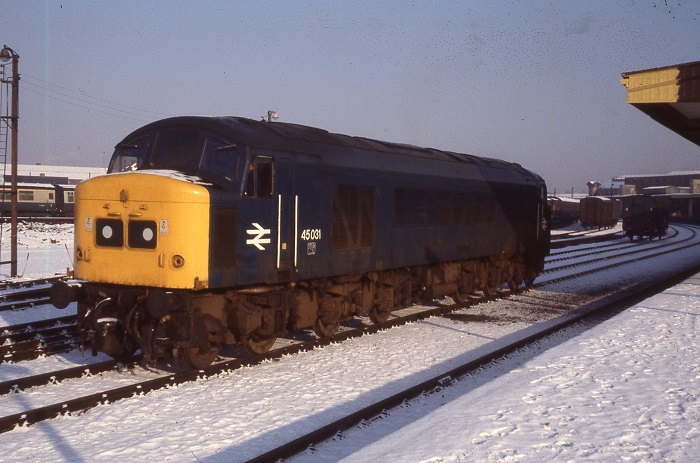
Ice on the overhead wires on the morning of January 29th caused cancellation of services between Coventry & Birmingham International.

More snow fell on February 12th from a storm moving south to north, six inches fell on the southern Pennines in blizzard like conditions. Services were interupted between Coventry & Birmingham New Street. Blizzards re-appeared on 14th, particularly in the east, whilst more snow arrived on 15th with much drifting particularly in Lincolnshire.
(see below) From the camera of Ian Walmsley comes the above three views of two class 37's with snowploughs working on February 12/13th 1979 on the Dowlais branch.
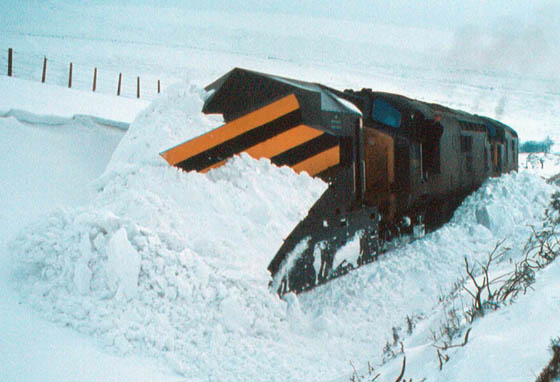
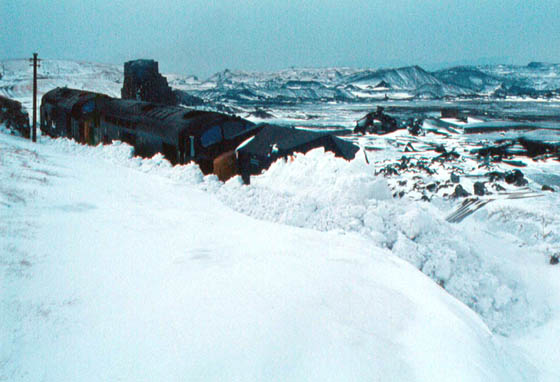
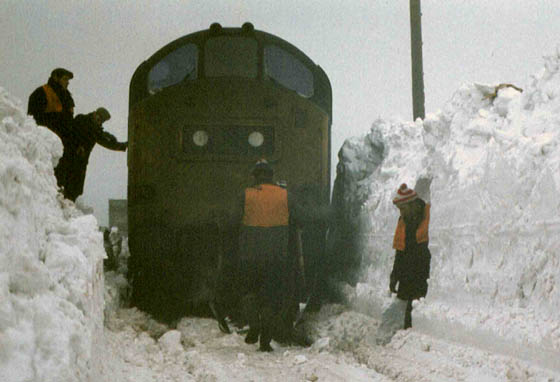
Heavy snowfall on February 14th brought much grief to the SE Division, Sole Street Bank on the Chatham line, saw four early morning trains stuck on the bank. Possibly the last to get stuck was the 06:45 Faversham to Cannon St which was formed of 8HAP + 4EPB. It was reported that the arcing was so fierce from the effects of the snow and ice that it caused the shoes to weld themselves to the conductor rail. Eventually the current was isolated either because passengers were alighting from the trains or perhaps because the authorities realised the need to get the passengers to a place of warmth by using ladders stored in the guards vans. Some passengers remaining with the trains were rescued by down stopping services. Two of the trains were freed after about six hours, the latter two were eventually dragged back to Rochester, by which time the trapped commuters should have been making their regular journey home! It is also reported that the pub in Sole Street did a roaring trade this day.
Across the Pennines at one point (14th) only the ex-L&Y Calder Valley route was open. Also on this day an evening Sheffield - Manchester diesel multiple unit (51930 & 52047) collided at Chinley with 40055 working a Tunstead - Margam stone train. Six people were injured including the multiple unit driver, whilst 45063 eventually rescued the freight train. The snowy weather continued in the area the next day with the Buxton snowploughs in constant service, frequently occupying the paths of cancelled passenger services. Snowploughs were also operating over the Settle & Carlisle, which included their use to rescue passengers from a stranded bus, the passengers were taken in the locomotive cabs to Skipton, the locomotives later ran out of fuel having returned to their ploughing duties.
On February 15th & 16th heavy snow brought chaos to the Midland mainline south of Leicester, the 20.00 Sheffield - St Pancras of the 15th was noted at Luton at 7.30am the following morning. Delays were also incurred due to a St Pancras guard's dispute on 19th and by a nationwide maintenance dispute the next day. Drifting snow on the ECML on the 15th between Stoke & Doncaster brought out two Class 31s with ploughs at each end, other Class 31s assisting a number of local diesel multiple units. On the GE a thirty foot deep drift was encountered by a snowplough at Twenty Foot River. The Colchester snowploughs were in during this period, being hauled by a pair of Class 37s on February 17th and later noted at Sudbury with a Class 47. The WCML was also affected though not as seriously, with ice continuously disrupting the beginning of the morning services. And regrettably a railway worker was killed on snow clearing duties near Rowley Regis.
On February 15th the Leeds portion of the Poole service was not combined at Sheffield, being noted with Finsbury Park allocated 31219 running about 100 minutes late. Also this day the 1O19 Newcastle - Poole (the Newcastle portion?) was noted at Birmingham New Street with 33104 running 460 minutes late. Also at New Street this day Cricklewood allocated 47201 was departing an hour late with the 1E64 10.15 Birmingham New Street - Norwich.
In the Manchester area a dispute affected diesel multiple unit refuelling created more disruption leading to greater use of Type 4s on the Blackpool - Manchester services, 46020 & 46030 were called in to assist, each with five coaches. February 23rd found 25131 on the 08.10 to Southport, whilst 25042 was one of four diesels working the Manchester - Oldham - Rochdale - Manchester circuit. Allerton depot was affected by a dispute concerning diesel multiple unit maintenance creating a major reduction in local services. Not that the multiple units were alone in this blacklisting for maintenance men in the London area (Finsbury Park) were refusing to work on 'foreign' power, this occurring at the height of the bad weather. Peterborough became an emergency refueling center, locomotives from both north & south being exchanged to minimise service dislocation. In conjunction with this and the bad weather stock diagrams became hopelessly confused, so much so that 55011 and two coaches worked a round trip to Leicester on February 21st.
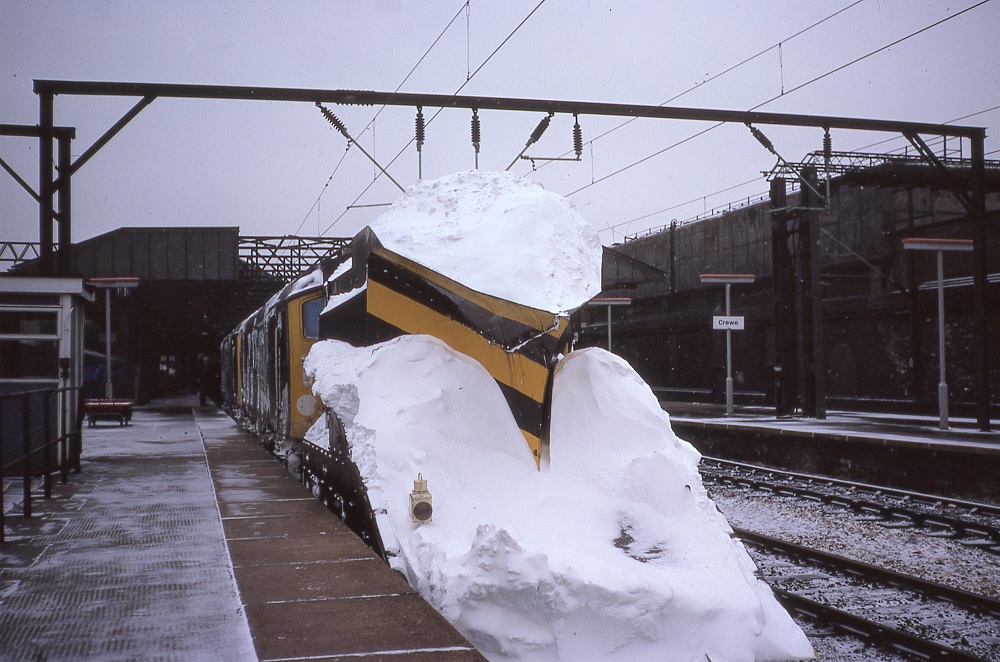
On February 16th 25285 & 25172 with two snowploughs departed Carlisle for the Settle & Carlisle line. They were heavily engaged between Appleby and Blea Moor, during the day they returned to Appleby for a crew exchange, the fresh crew having arrived with a Class 25, which then took the other first crew back to Carlisle.
On February 16th the 13.49 Stoke on Trent - Lincoln was worked by 31222 and four Mk1 coaches after the regular multiple unit stock became snowed up at Lincoln.
On February 16th a Plymouth - Penzance local with two coaches was top-n-tailed by 46006 & 45034, this combination returned to Plymouth later in the evening.
*****Update March 2013 *****
The Midland mainline and some of its feeder lines were also impacted by the heavy snowfall. The following notes and snowplough picture come from the memories of Vic Smith, who in 1979 was the Traction Maintenance Supervisor at Leicester TMD:
Heavy snowfalls in February 1979 brought severe disruption to services. It was the only time in my railway career where I spent a full 24 hours on duty, doing what would today be described as a railtour. I struggled through the snow, arriving at the depot at around 11am, having taken the required rest period from my previous shift. I could see two type 2 s (Class 25) being coupled up between the two independent snowploughs. The Train Crew Inspector welcomed me with the news that I could be in for a long ride as conditions were deteriorating fast. Gathering up copious supplies of breakdown food and tea, I climbed aboard one of the locomotives. A fitter was already on board with shovels, lump hammers and a couple of large adjustable spanners. Knowing the previous difficulties of keeping the ploughs on the rails, he had also taken the precaution of loading a couple of hand jacks into the back cab. One of the snowploughs had previously disgraced itself by derailing at the Coalville Depot Open Day in 1978. This was not the first time that this had happened and so it was despatched to the weighbridge at Derby, where it was found that the axle loadings were unbalanced, so corrective repairs were made.
Before leaving the depot, one of the old steam hands gave me a couple of small wooden taper wedges, similar to door stops. He said I might find them useful. We were very soon out onto the main line heading north towards Nottingham. On arrival at Syston Junction, we were advised that the line was blocked with deep snow between Melton Mowbray and Peterborough and that we were clear to plough through to Peterborough. A stop was made after Melton Mowbray station to lower the front blade plate and lift the side plates in preparation for snow clearance. Ploughing commenced, it was a great experience to see the snow flying past the sides and over the top of the locomotive. It was very difficult for the driver to see the road ahead, we were provided with goggles but did not use them, preferring to keep our heads inside the cab. We were brought to a stand by a signalman and pilotman waving red lamps and flags. Although we were advised the route was clear for us, the track gangers and local council were busy clearing the level crossing to enable the gates to be opened for road traffic. Once they had all cleared from the crossing, we set back and had a run at the snow. They did not look impressed as we flew through the crossing and they were all showered with the flying snow.
Approaching Peterborough on the Midland line we could see two expresses stationary in the snow on the adjacent East Coast Mainline. A quick run round at Peterborough Station, picking up a pilotman and we were wrong line working towards the stationary trains. There appeared to be plenty of staff on hand, so we were quickly sent back to Peterborough. We returned back to Leicester, retracting the blades at Melton Mowbray and then told to head south to Bedford. The snow deepened as we approached Market Harborough so the blades were again repositioned. All went well until Kettering Station, fortunately entered at slow speed. There was a large bang and grating noise as the extended side plates buckled and proceeded to plough up the first few yards of the station platform edging. Oops!
A little further down the line there was a disturbing crash and bang on the cab roof. No one had seen anything and nothing was obvious until reversal at Bedford. The driver went to change over the front and rear lamps and came back with a smile on his face. The lamp which normally sits on the plough blade bracket was missing. Now I knew what the taper wedges were for!!
The return to Leicester was thankfully uneventful as it was now dark. Onto the depot, a change of crew, then off to Nuneaton Trent Valley, where numerous movements were made in the station area. The driver was asked if he was prepared to work on the West Coast mainline with a pilotman. The answer was positive, but higher authority appeared nervous about us ploughing under live wires. We were soon sent back to Leicester, then immediately turned round for another trip to Bedford. Dawn was breaking as we arrived at Leicester. Another crew change and then off to Corby via Melton Mowbray. Before entering Corby Tunnel we had to break up a large lake of ice which had formed above rail level just inside the tunnel mouth. Large icicles could be seen hanging from the roof of the tunnel. As we drove through the tunnel the plough started breaking them off, one crashed through the roof mounted route indicator glass and another cracked the secondman's front window. A very frightening experience.
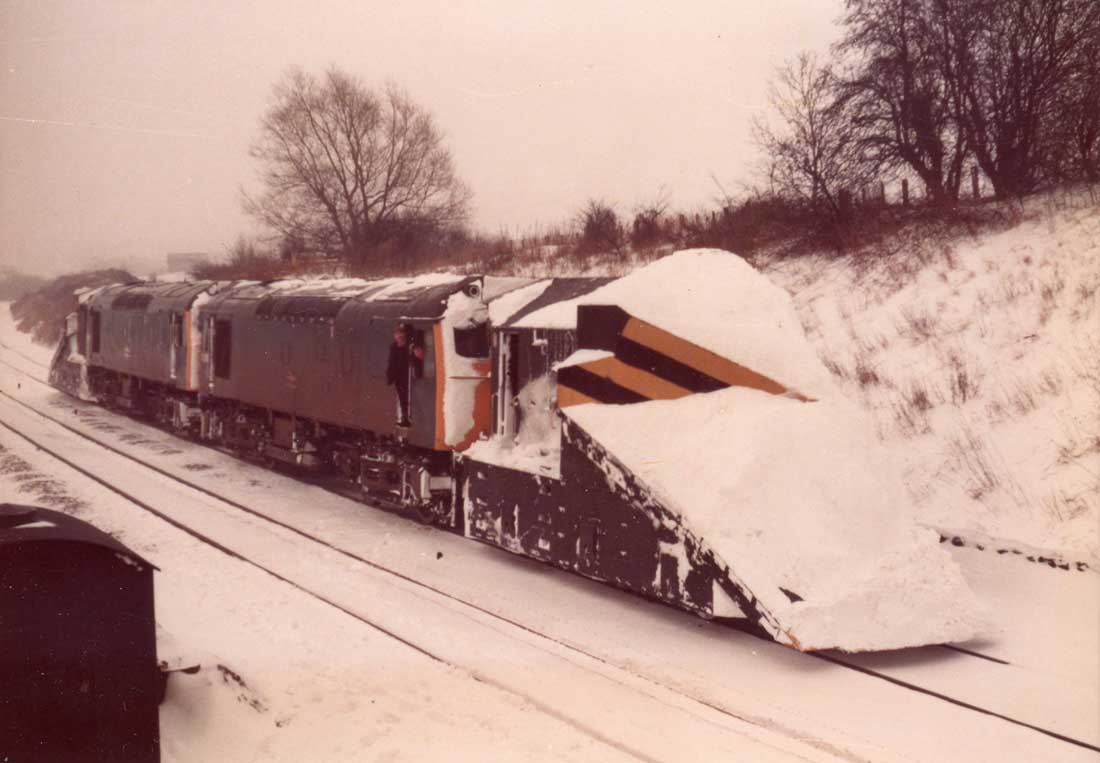
We returned from Corby, expecting to go straight back to Leicester but on arrival at Melton Mowbray were sent up the Edwalton line to clear the little used Holwell branch. We finally arrived back in Leicester, very tired at around 11am, the snowploughs having behaved very well on this occasion. This was the longest railtour I have been on and I was fortunately paid for the privilege.
My long absence had caused concern at home, as news was announced that a railway worker had lost his life whilst carrying out snow clearance duties. The tragic accident occurred at Rowley Regis in the West Midlands and highlights the dangerous conditions the staff on the track were prepared to work under to keep the railway running.
**********
During this spell of bad weather the maintenance staff at Finsbury Park (London) were in dispute, only working on locomotivess allocated to their depot. Initially this stranded many 'foreign' locomotives at Finsbury Park, with insufficient locomotives available to cover the diagrams. East Coast Mainline trains were changing locomotives at Peterborough station, using the locomotive depot as the the main refuelling point. This brought about a very unusual working into Leicester when Deltic 55011 appeared with a two coach local service from Peterborough. 55011 coming onto the depot for refuelling. I believe that this may have been the only time that a revenue earning Deltic locomotive has been onto Leicester TMD.
On February 17th a day trip was made from Derby to York, perhaps to witness some of the snowy conditions. 45037 took us to York, en-route 31407 was noted at Attercliffe with large snowploughs. At York there was enough snow on the ground to provide a little atmospher to an otherwise dull day, as shown below. At the end of the day 47467 returned us to Sheffield Midland, with 45076 taking us on to Derby.
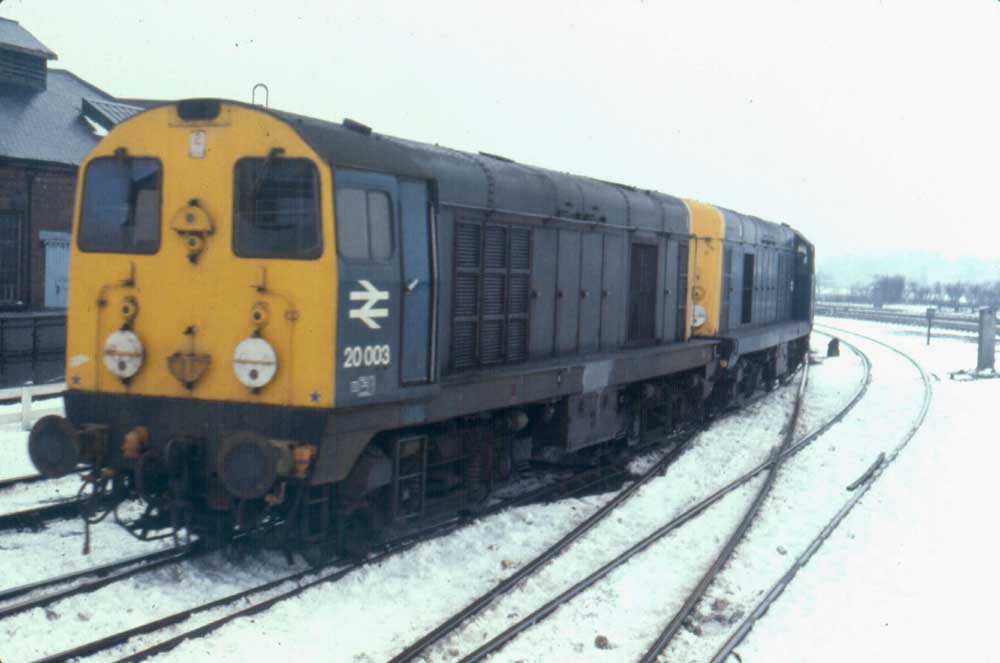
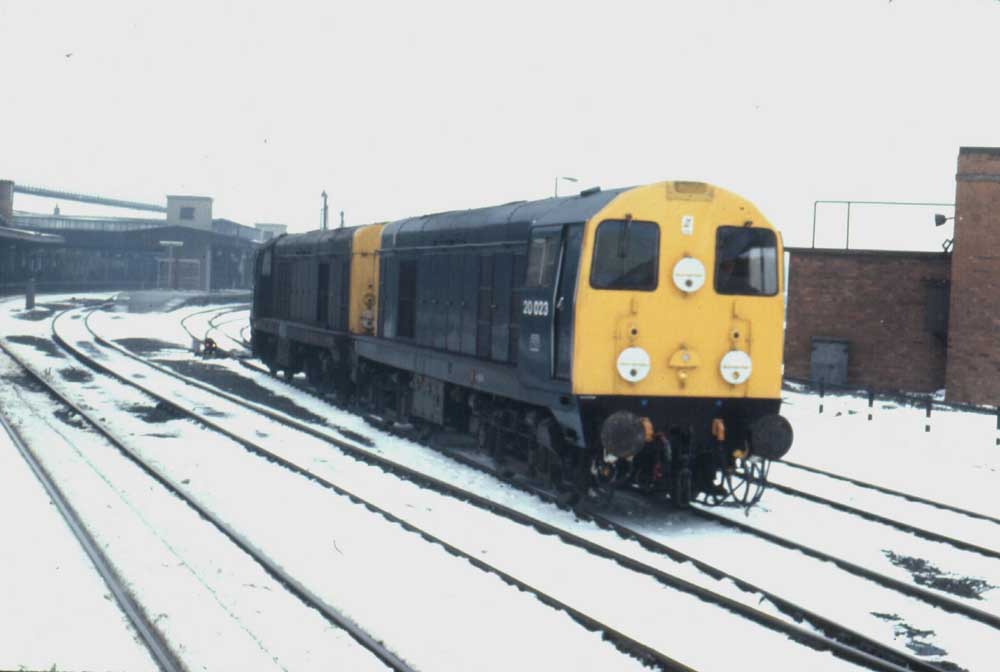
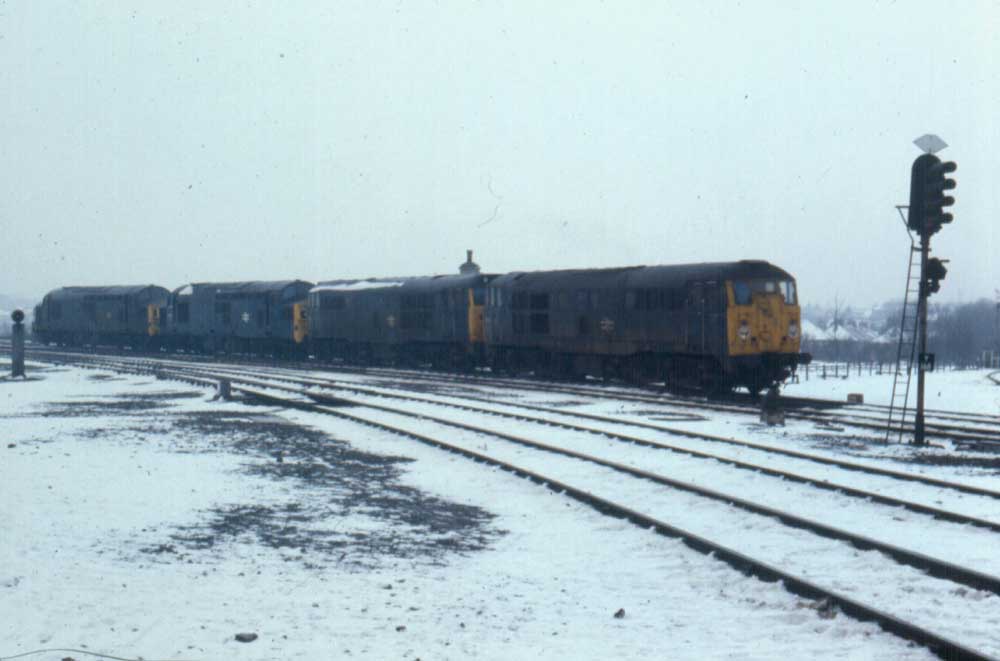
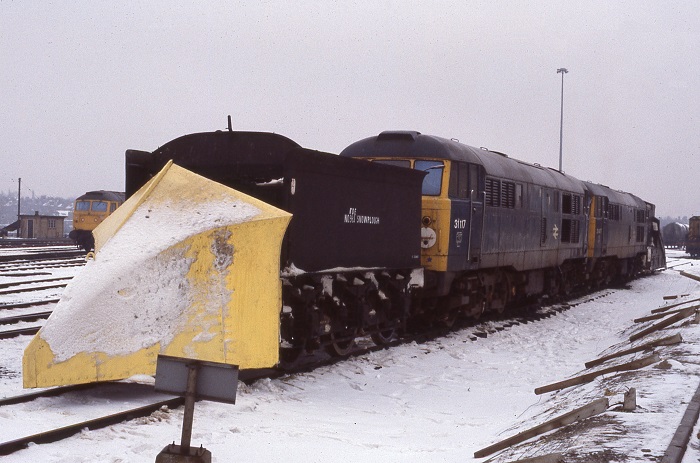

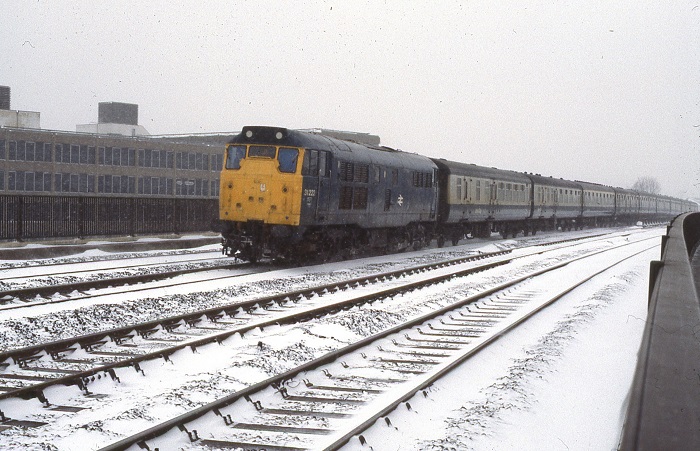
In the middle of March a low pressure system over the North Sea brought heavy snow to north and central England. As well as affecting many scheduled services it created problems for several scheduled charters over the weekend of March 16th - 18th. On March 17th such were the vagaries of the weather that the Severnside Railtours 'Fellsman' railtour from Cardiff to Carlisle with 37203 & 37189 was terminated at Gloucester. The tour was to have used the Settle & Carlisle but pathing issues due to bad weather as well as the collapse this day of Penmanshiel tunnel on March 17th were part of the reason for its termination. In the opposite direction a Merrymaker from York to Cardiff was three hours late in reaching Sheffield on the outbound leg behind 47525, here the tour was terminated and returned to York.
York would also be the termination point of the RPPR 'County Durham Crusader' on March 17th which had come up from Kings Cross behind 40030 with the intent to visit lines in the north-east, but was terminated at York due to heavy snow further north. Another railtour running in the West Midlands area using a diesel multiple unit encountered blizzard like conditions in the Trent Valley, but was generally able to maintain the railtour schedule.
An adventurous Western Region Merrymaker from Ealing Broadway to Aberdeen & Inverness (cost 9 adult) from March 16th - 18th required much endurance from its participants and failed to reach Inverness. A missing guard caused a ninety minute delay from the outset, the train was held south of Crewe for 210 minutes, not resuming northbound travel until about 5am. At Stirling it was advised that the excursion would now terminate at Aberdeen due to bad weather and the lateness of the train. Aberdeen proved to be misty and cold with snow on the ground. On the return journey the Sunday morning brought glorious sunshine, with the Settle & Carlisle was used to Hellifield, deep snow was encountered at the higher elevations, with a Class 47 and two snowploughs in action at Blea Moor. On March 18th the 21.10 Leeds - Manchester multiple unit derailed seven of its coaches between Hebden Bridge and Todmorden due to snow blocking some pointwork.
The poor weather that affected these trips brought more severe icing to the Southern Region, although not as catastrophic as that seen in January & February. In the north the ECML between Newcastle & Darlington suffered from a heavy snowfall on March 17th, the first southbound trains from Newcastle didn't leave until 11am, whilst the local Berwick service was maintained despite closure of many roads in the area. However this day it was not the weather that would directly close the ECML but a massive rockfall within Penmanshiel Tunnel, with the death of two workers engaged in the installation of a concrete trackbed. ECML trains were diverted via Carlisle, not helped by more bad weather in the following weeks and a maintenance dispute at Scottish depots, leading to HSTs being used on the emergency Edinburgh - Dunbar shuttle, with a bus connection to Berwick.
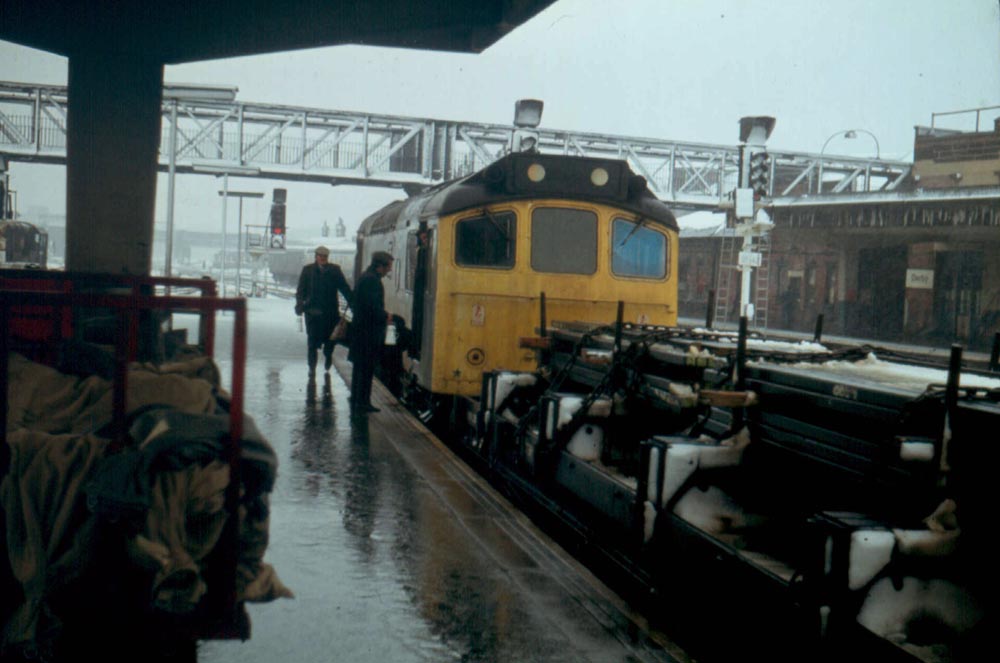
May began with snowshowers. However this did not last, by May 14th parts of the country were experiencing a heatwave. The heat buckled rails at Berkhampstead on the newly laid down fast line and also on the up Birmingham line flyover at Rugby. Both incidents caused delays and diversions. On the same date (14th) at Micheldever the heat buckled the down line, causing serious delays.
Extremely heavy rain in western Scotland on July 28th led to a landslip near Loch Awe which closed the Oban line for several hours, delaying at least two services.
During the second week of November the Southport area electric services suffered from icing problems, on November 10th many of the morning services ran late, often with the services doubled up to overcome the icy rails.
In the early hours of November 27th heavy rains caused an embankment collapse near Pyle, leading to the closure of the down line until midday on December 2nd and intermittent closure of the up line until December 2nd. Large amounts of spent ballast and larger stome were brought in to stabilise the embankment. Swansea - Paddington HST services started/ended at Bridgend, whilst many other longer distance Swansea services started or ended at Cardiff. A variety of freight trains were diverted via Tondu.
Drainage work in Kilsby Tunnel during recent months proved ineffective in dealing with the extremely wet conditions during the early part of December, services were diverted via Northampton.
Heavy rains on December 8th & 9th caused a landslip on the line between Seafield & Kinghorn, requiring a week of single line working until the slip could be dealt with.
Torrential rain coupled with strong winds on December 17th caused havoc on the WCML, bringing down the wires between Floriston & Quintinshill. Many northbound services were diverted from Carlisle to Hexham, Newcastle & Berwick. In the Glasgow area wires were brought down between Craigendoran & Cardross. A morning Glasgow - Liverpool service was reported over five hours late at its destination.
High seas closed the down line near Dawlish on December 21st. Single line working was instituted, except at high tide when bus substitutions occurred.
Heavy rain on December 27th & 28th causing extensive flooding on various parts of the Western Region. Temporary closures affected the Salisbury - Exeter, Castle Cary - Dorchester & Newport - Shrewsbury lines. On the latter the 15.08 Cardiff - Crewe with 46040 became stranded at Abergavenny whilst the 16.02 Crewe - Cardiff with 25055 encountered severe flooding at Woofferton, but was able to complete the journey. The Central Wales lines was closed south of Llanwrtyd Wells, not being opened until the next day. The Barnstaple and Looe branches were also impacted, the latter using buses on December 28th & 29th. Such was the flooding on December 29th that a Class 50 was trapped at Newton Abbot depot, unable to take up its book working.
Heavy snow fell in Lancashire, Yorkshire and the southern end of the Pennines on December 29th.
![]()
Snowy days in the 1960s
Snowy days in the 1980s
Page added April 15th 2004.
Page updated July 7th 2025.